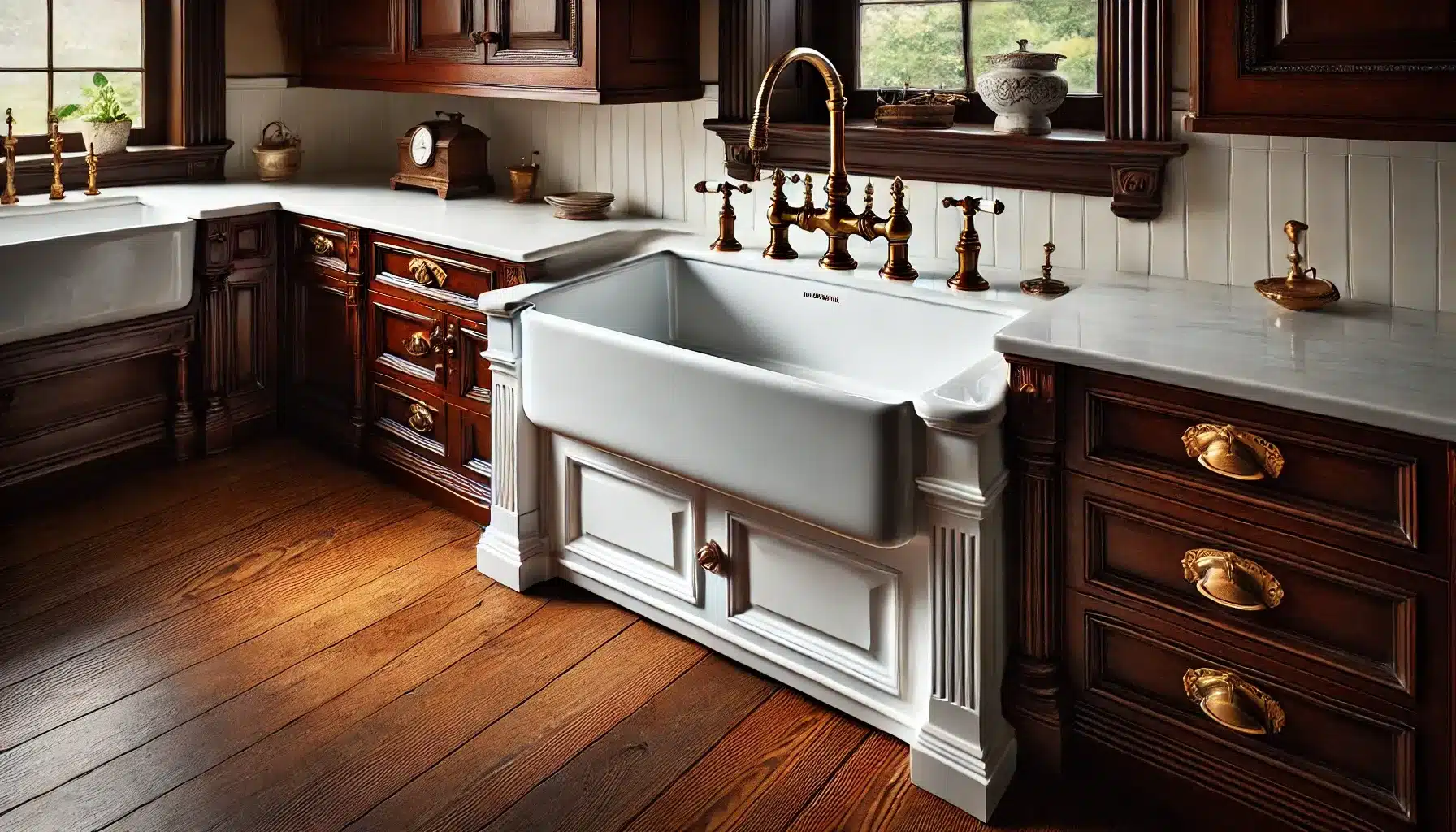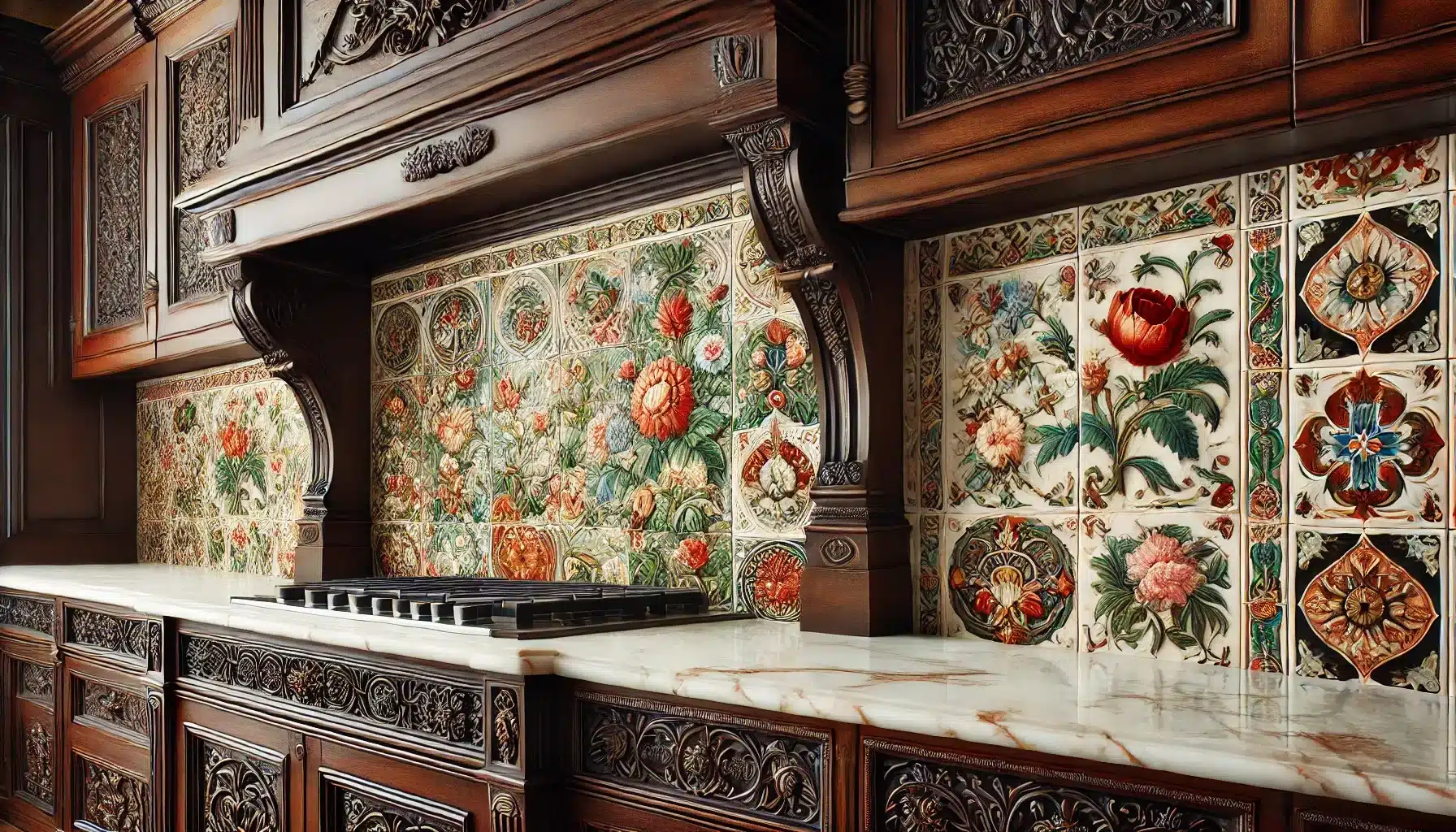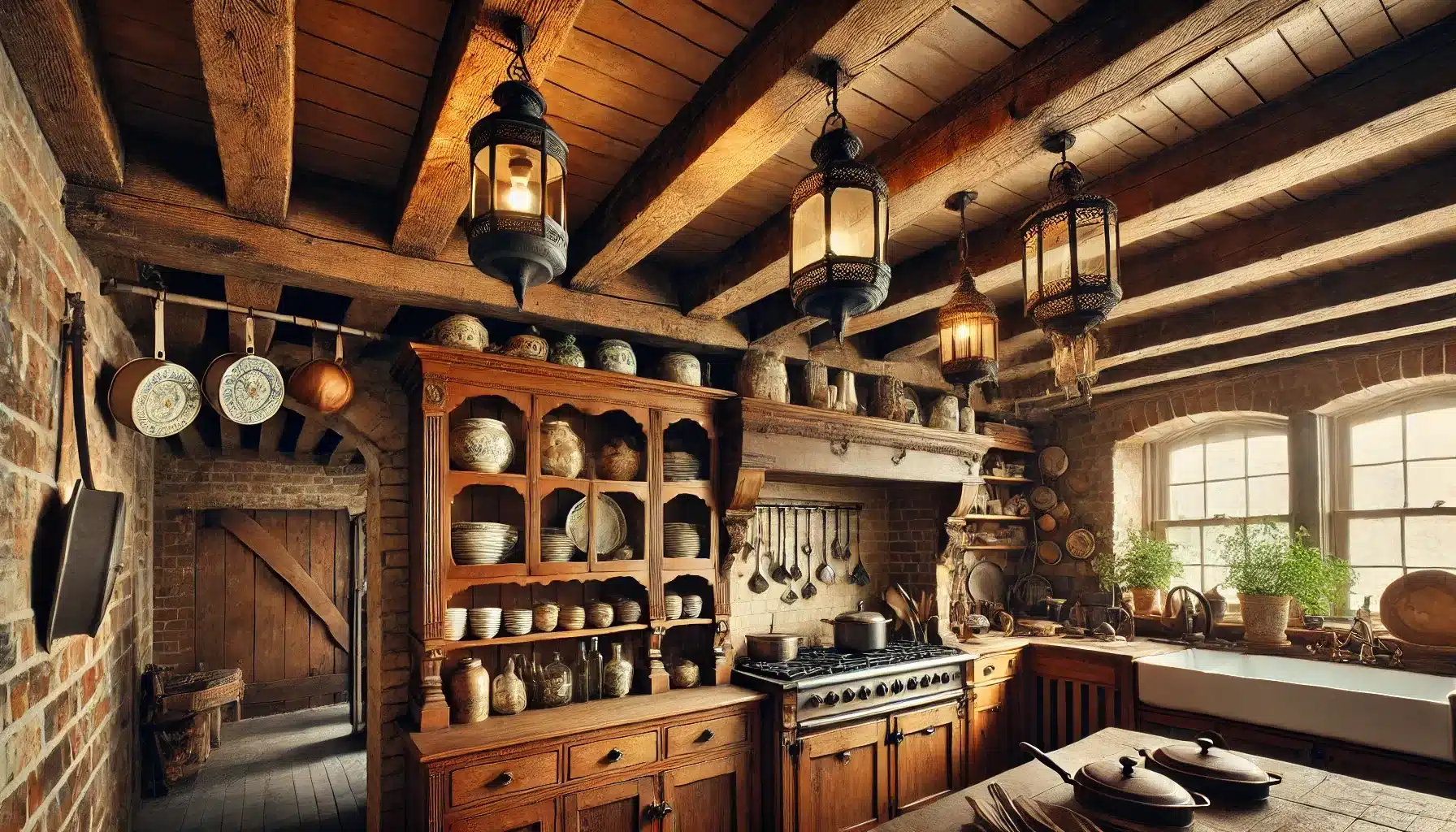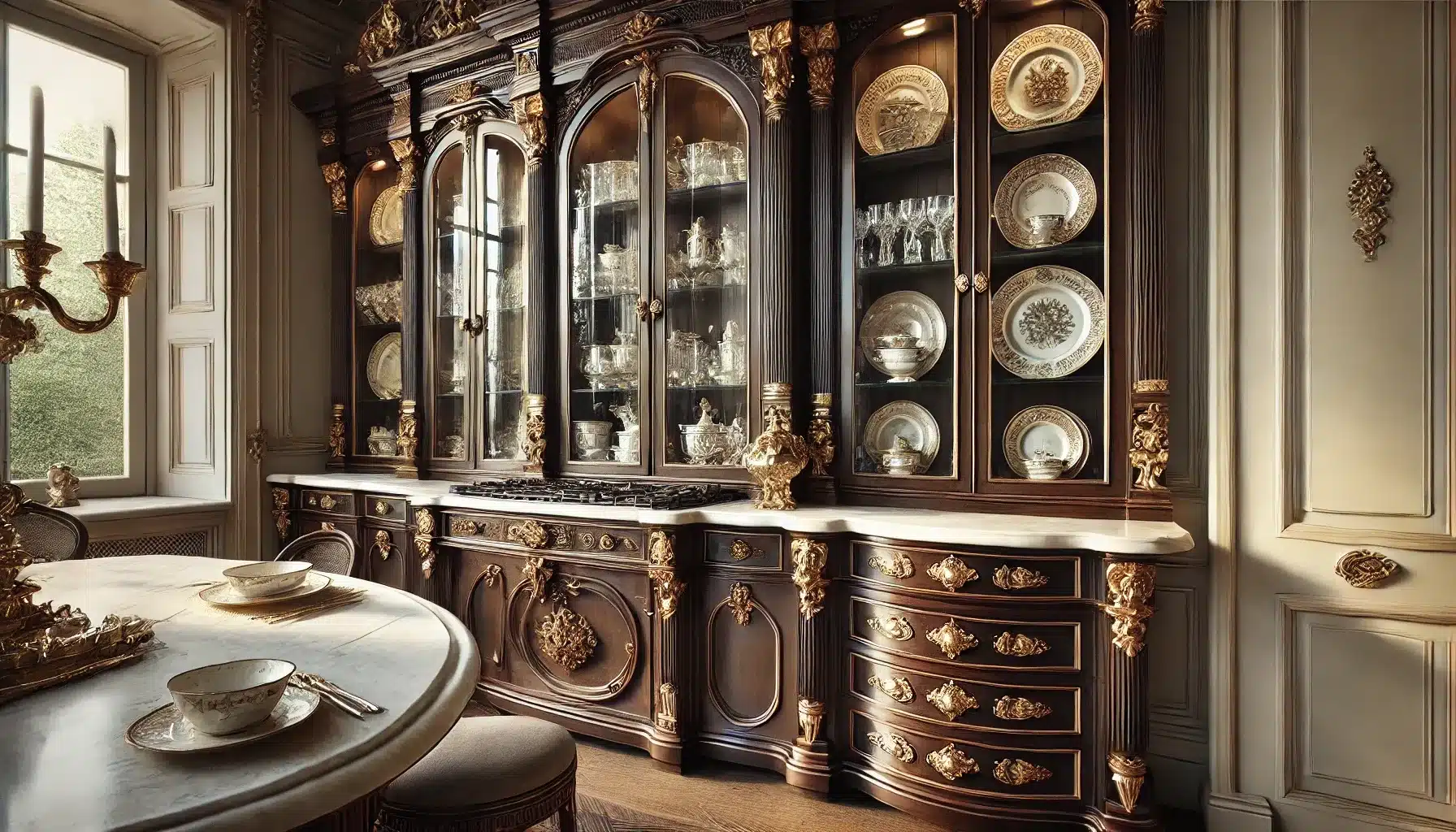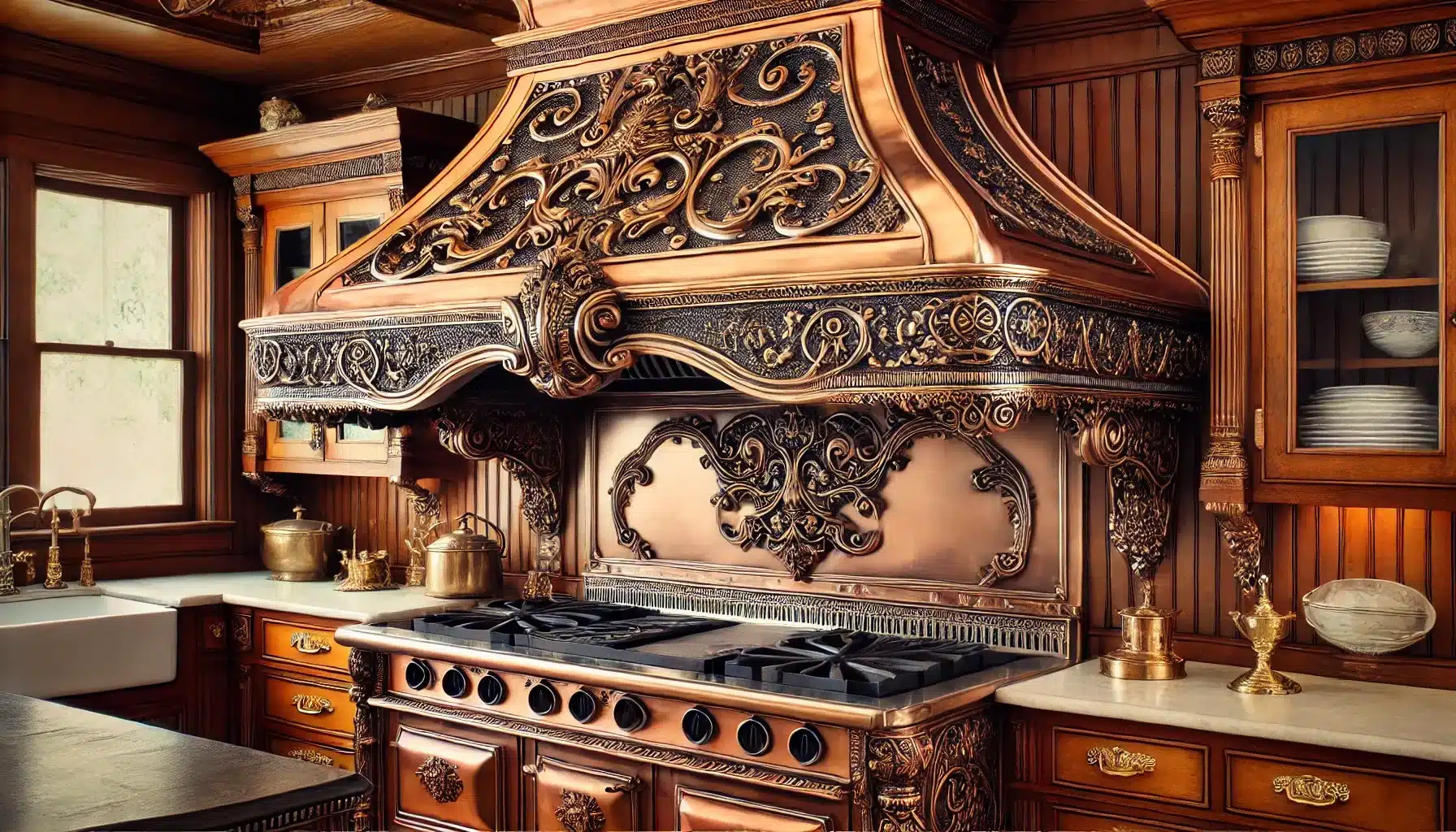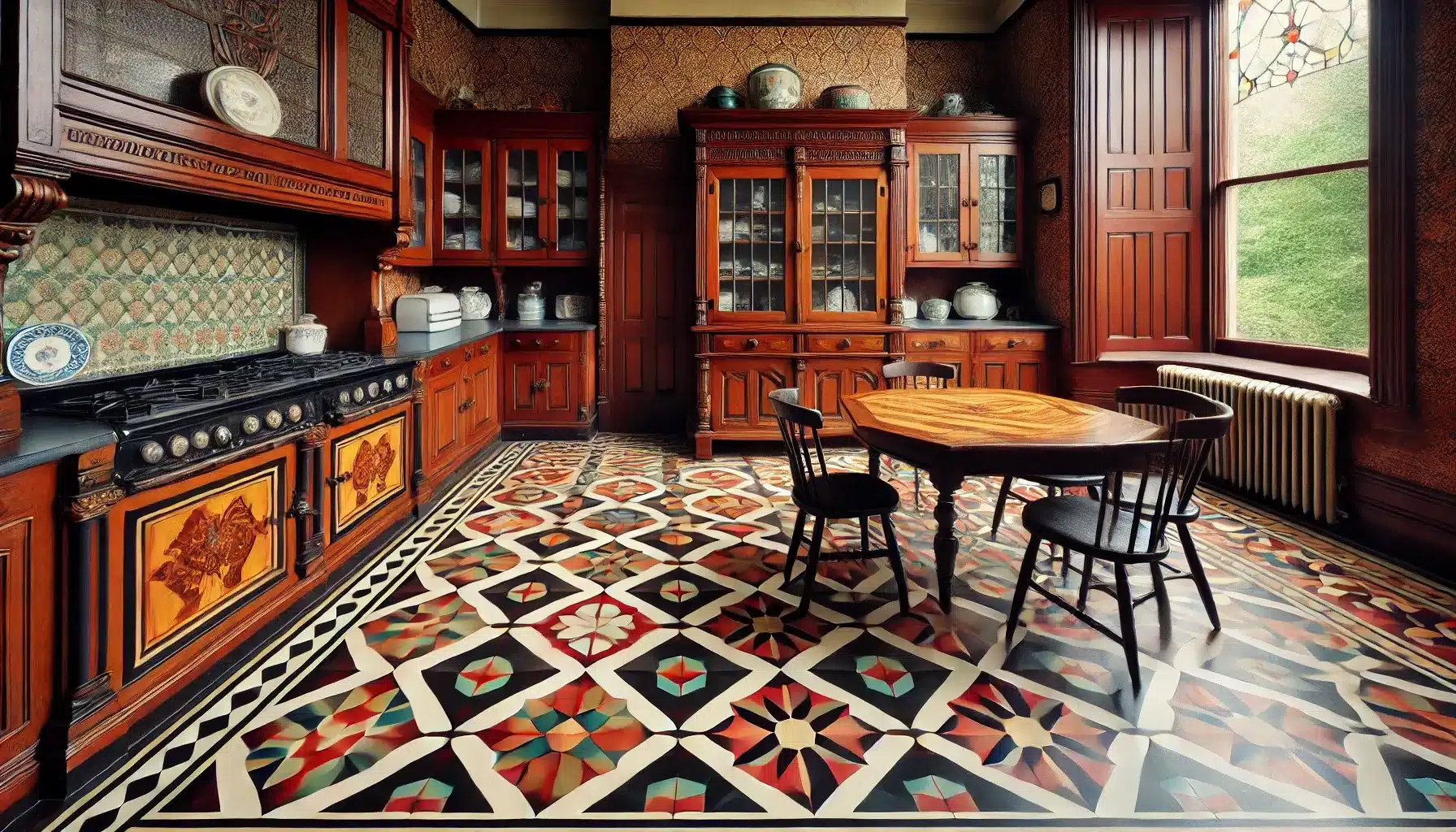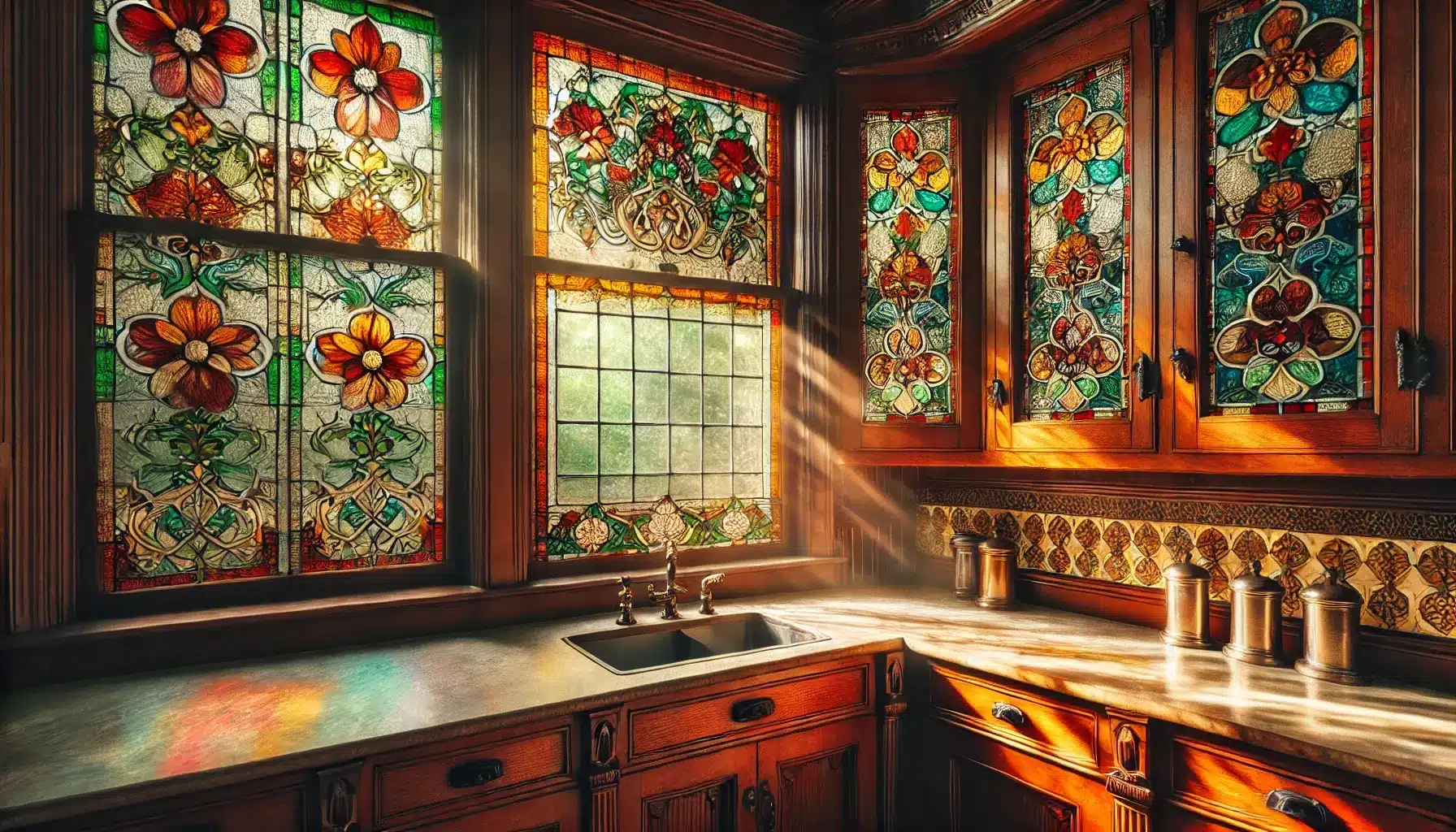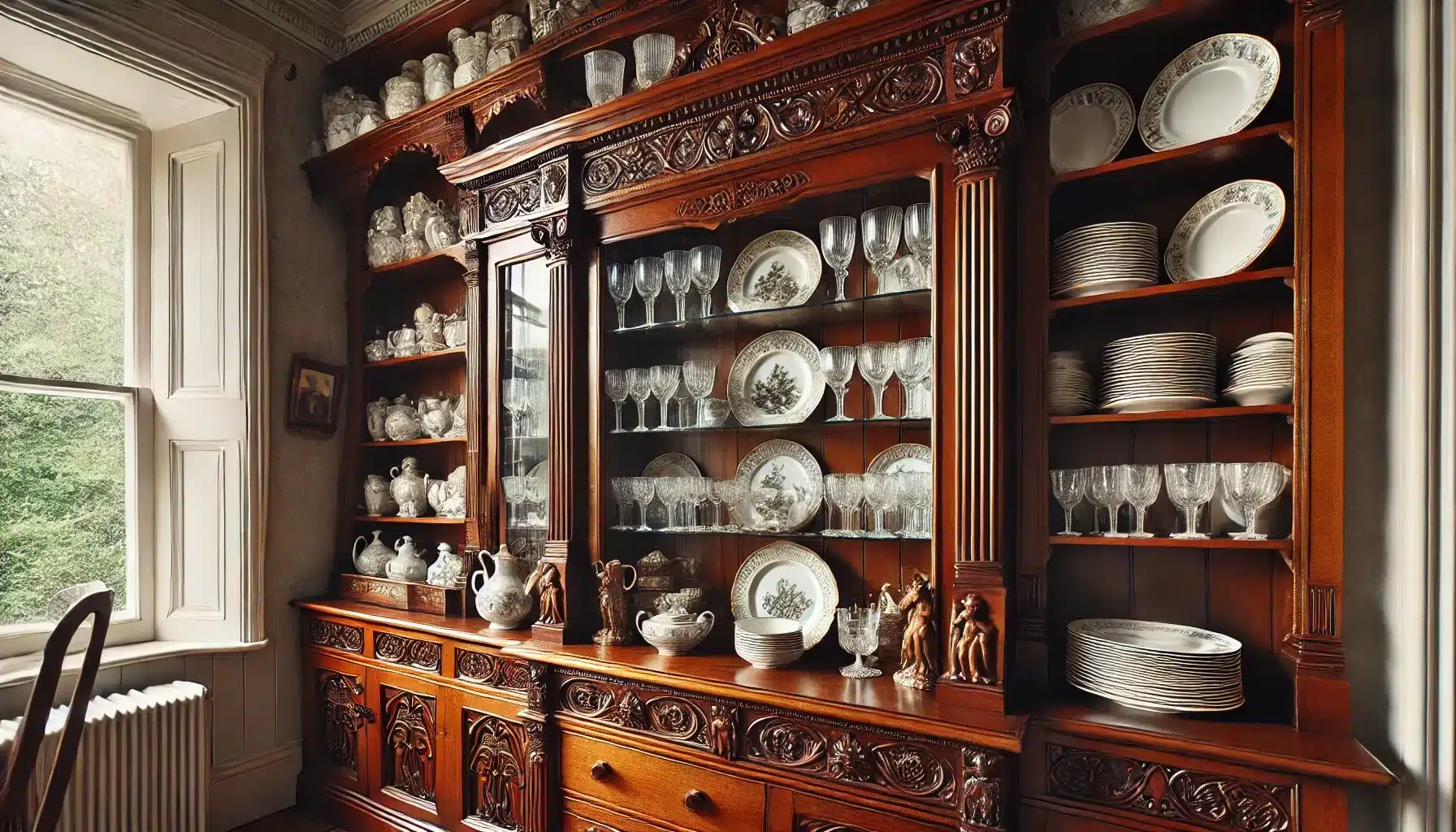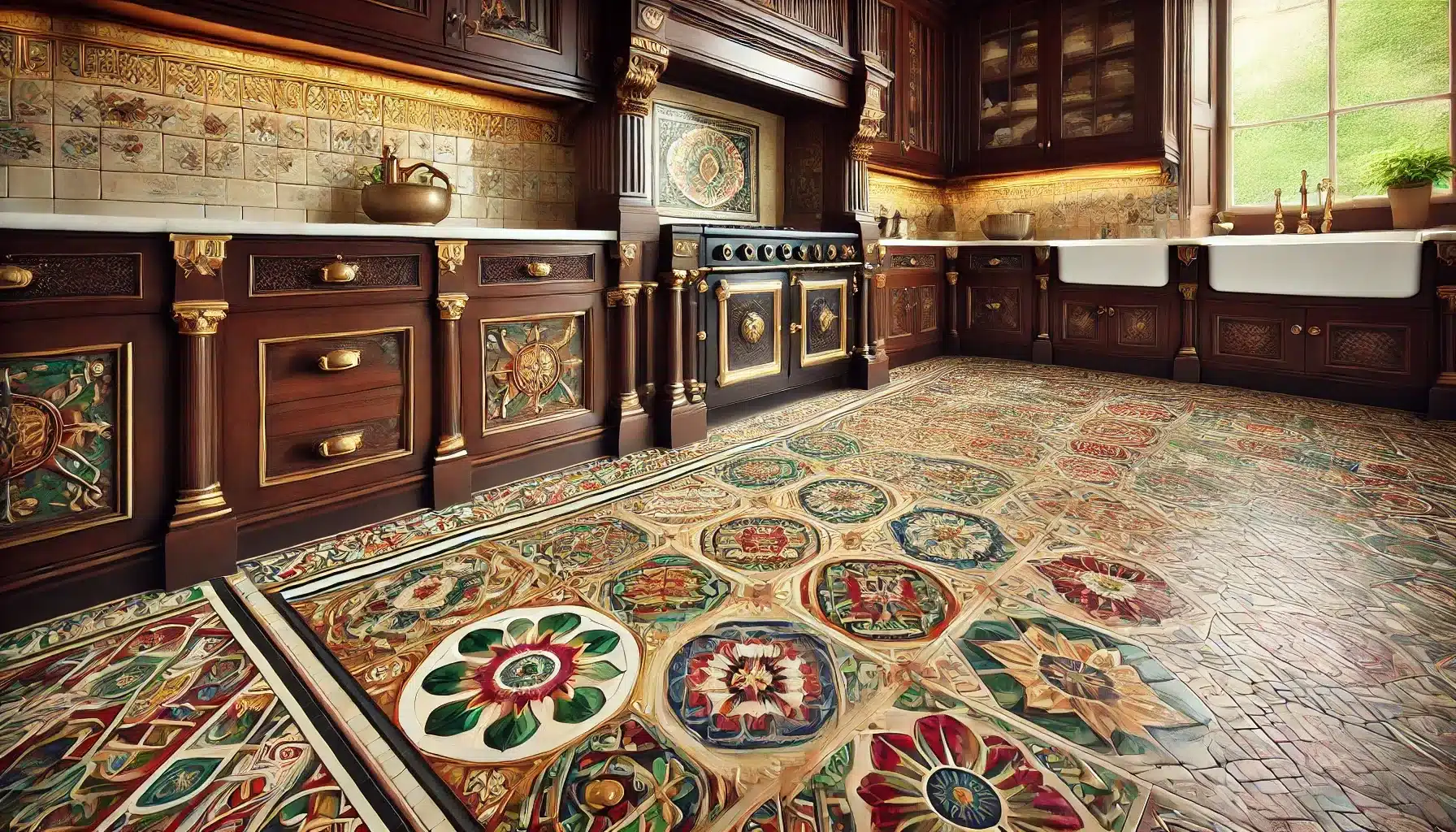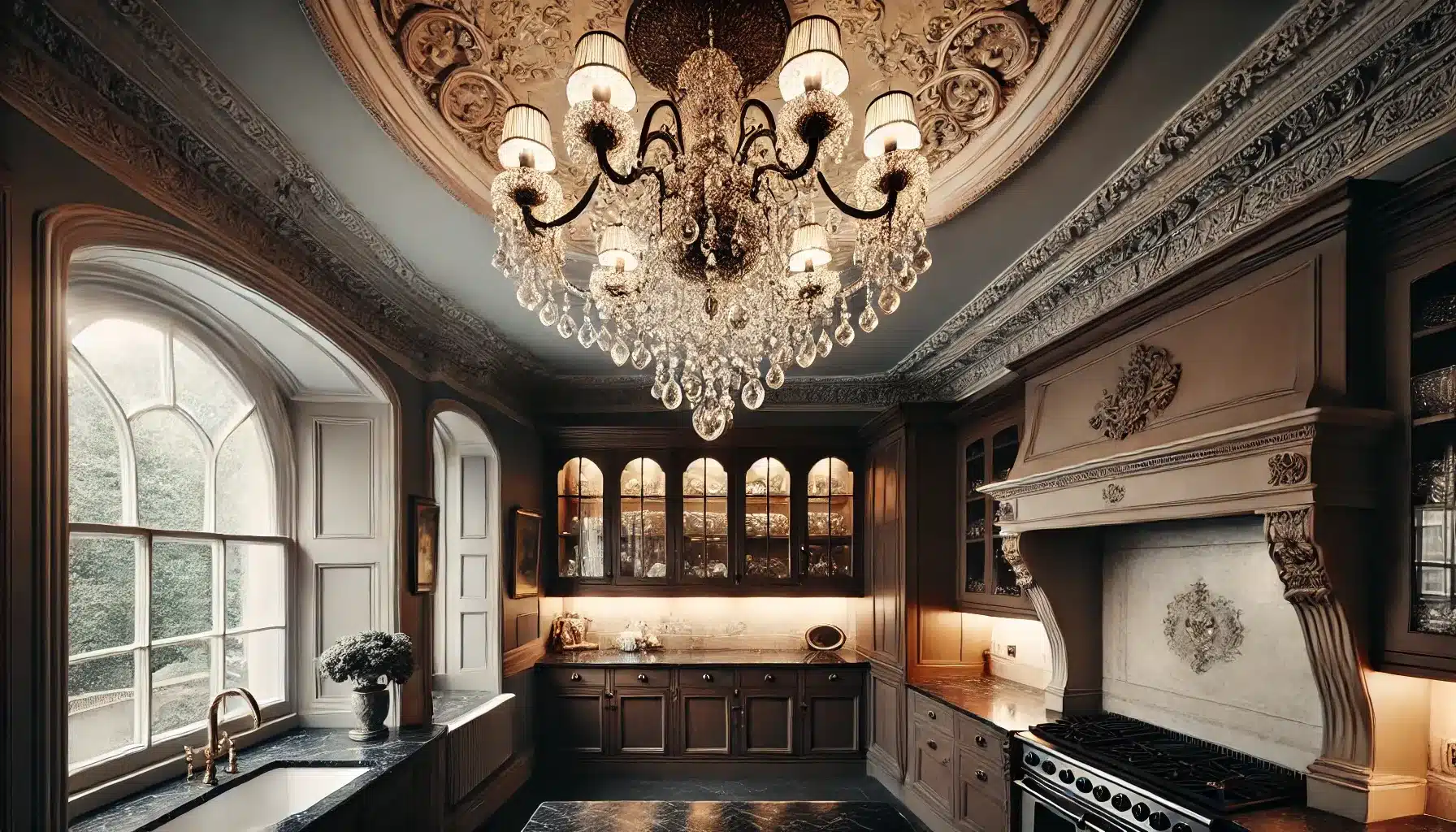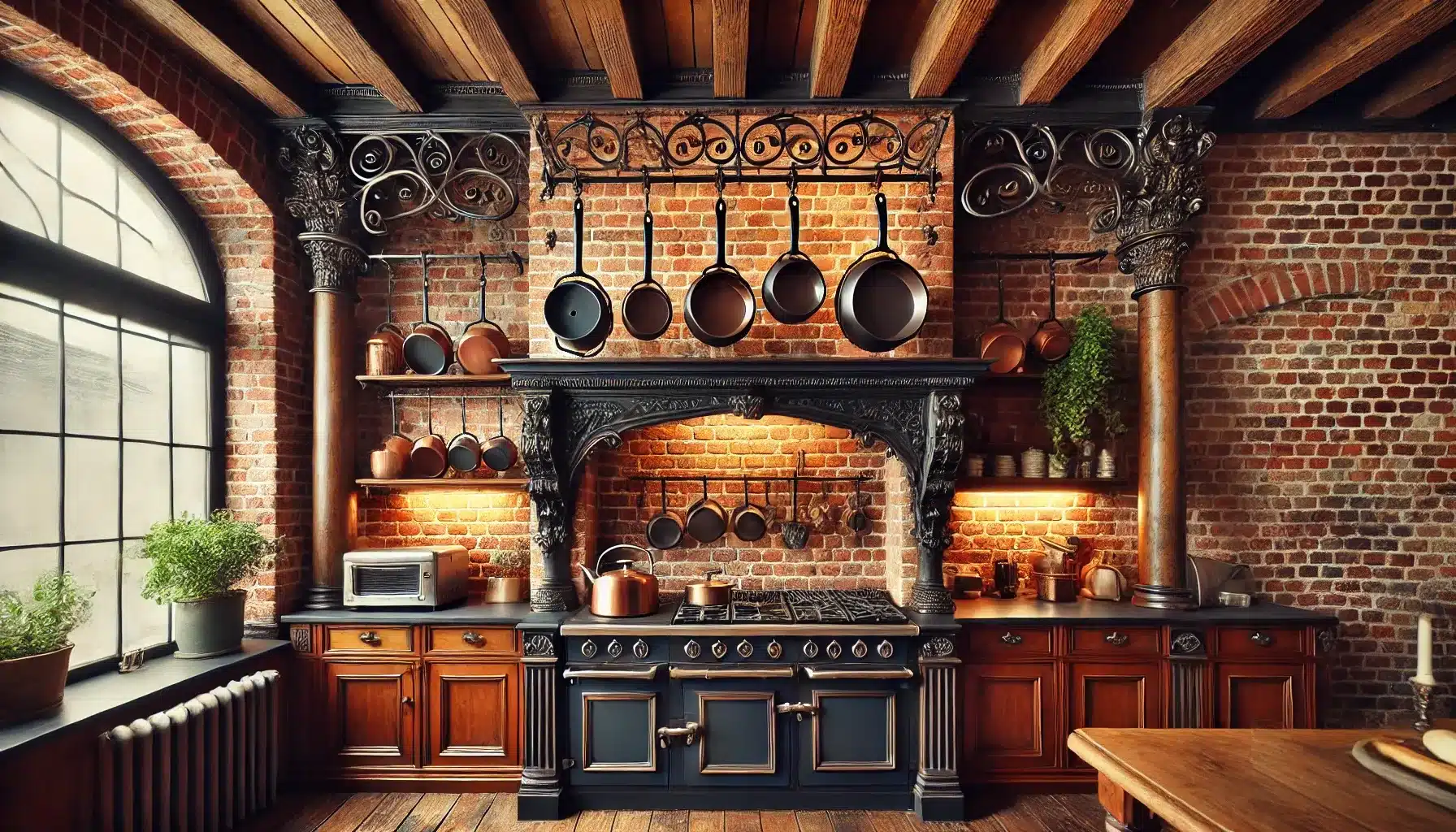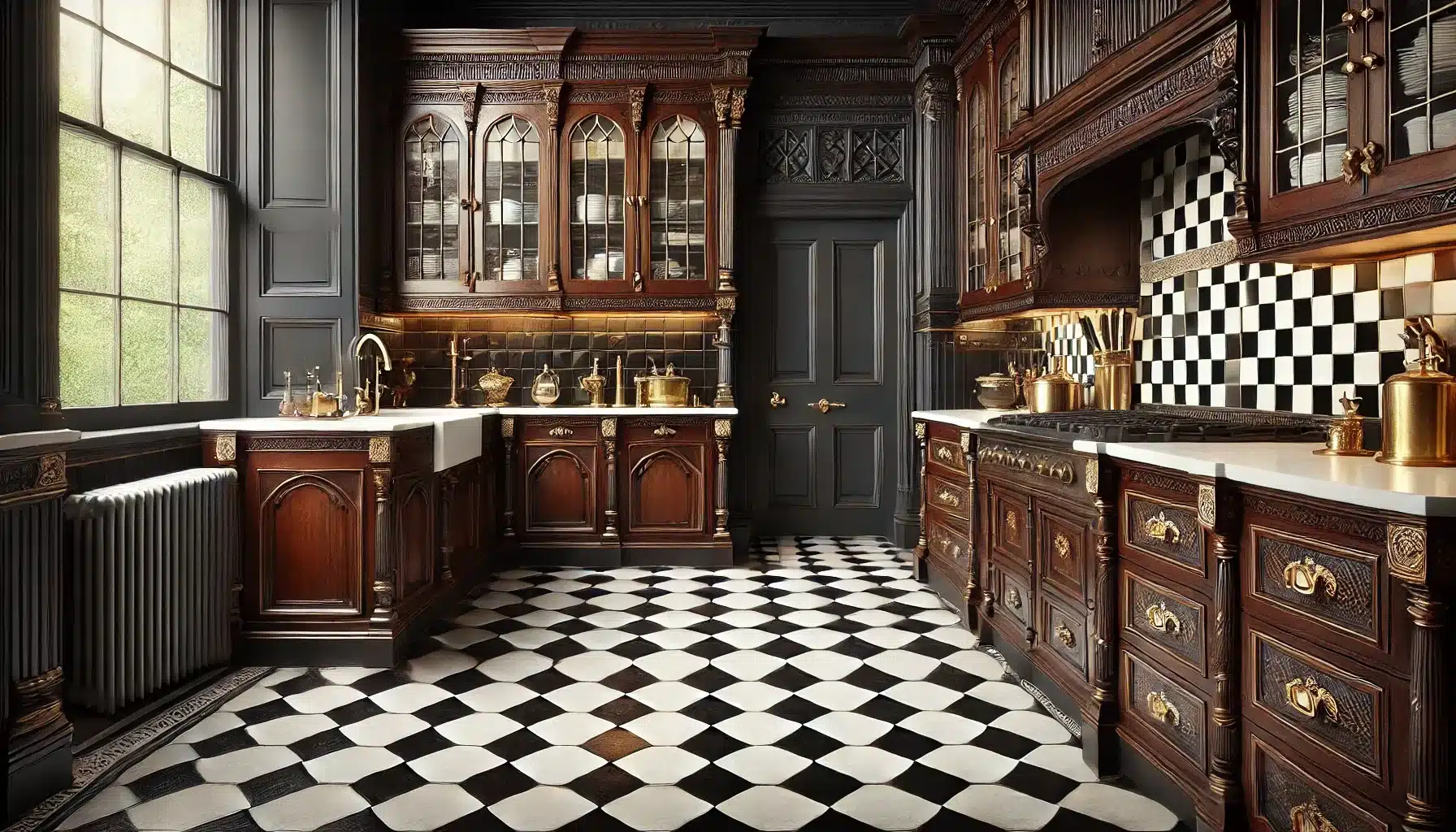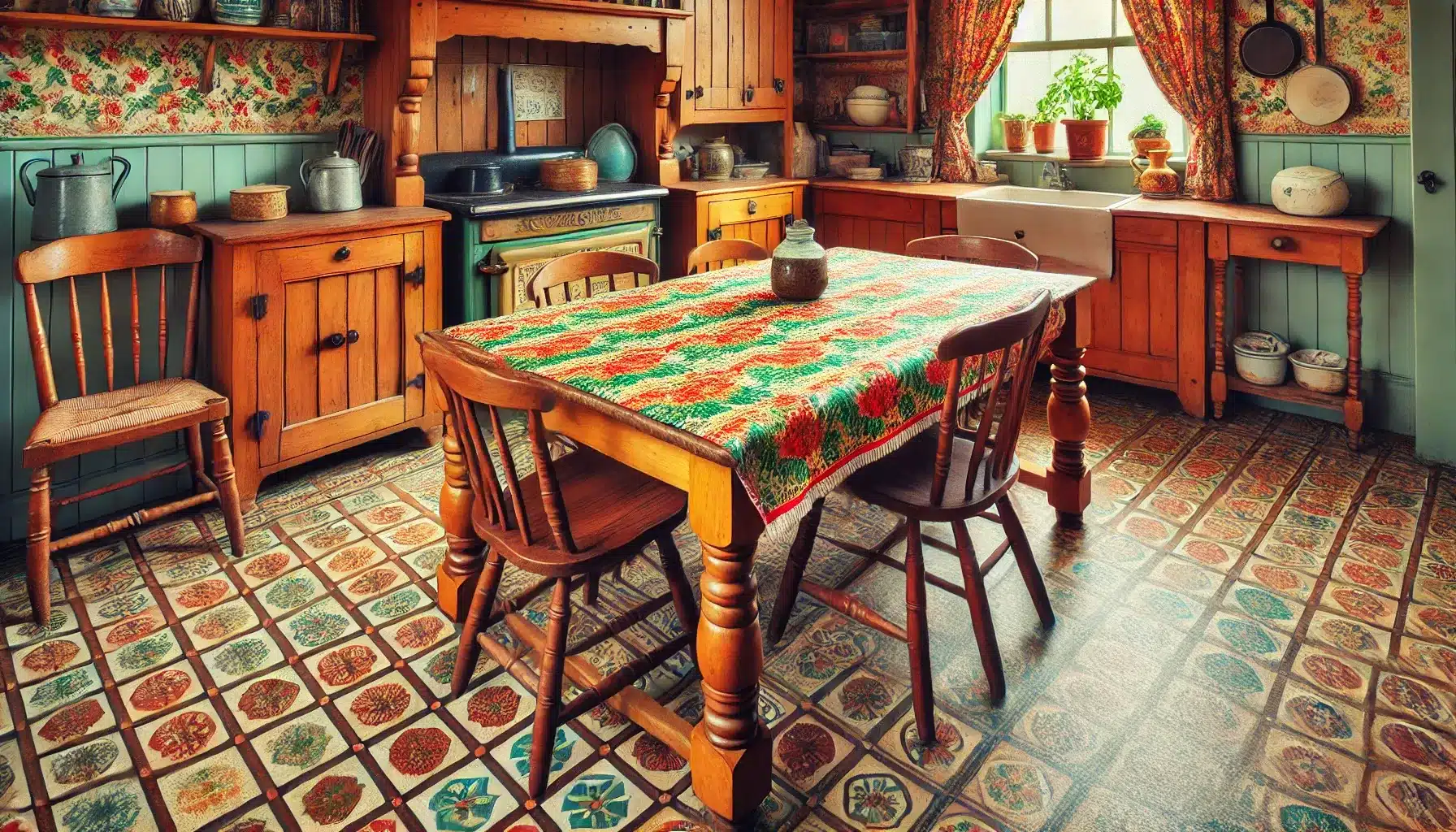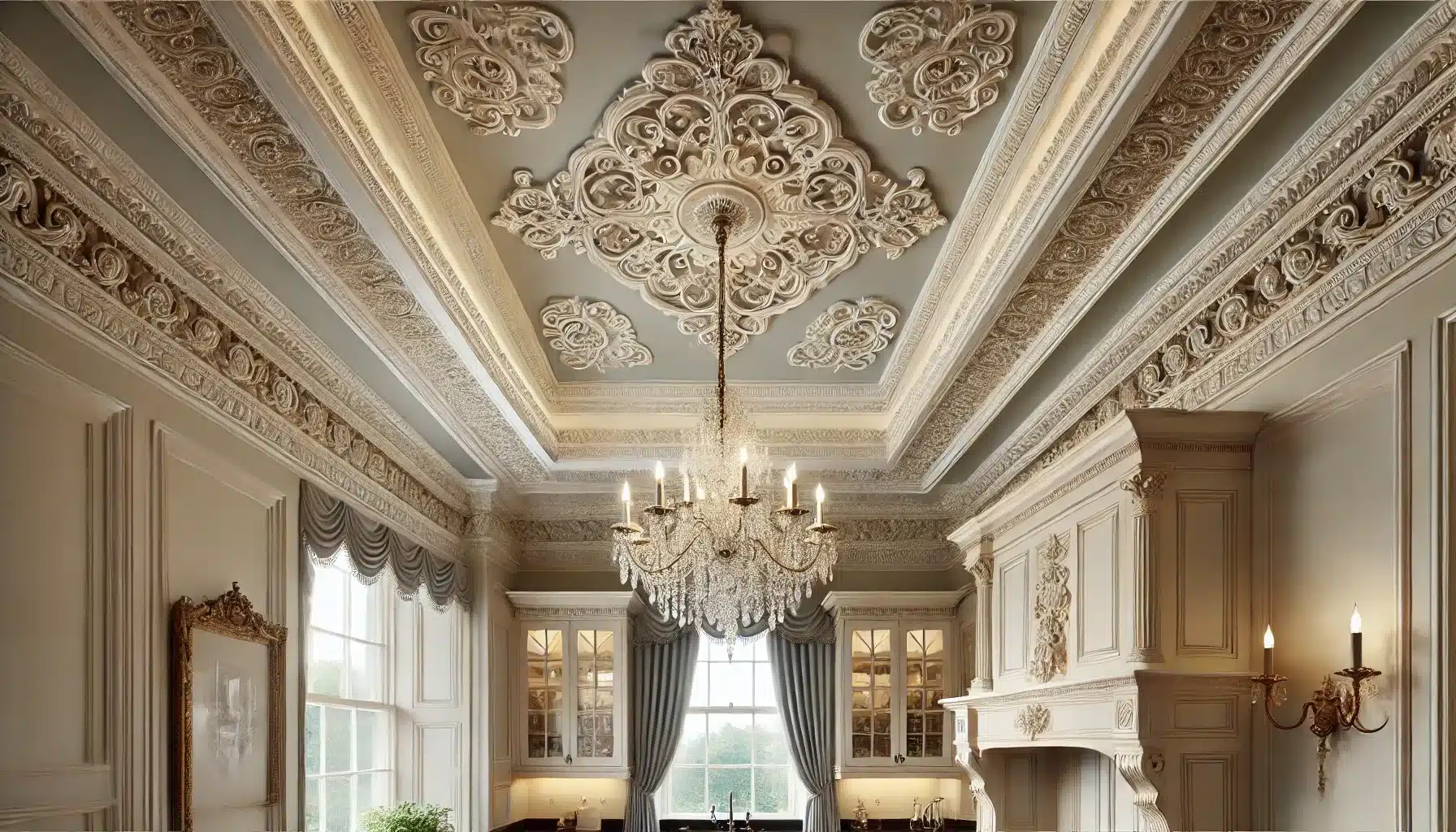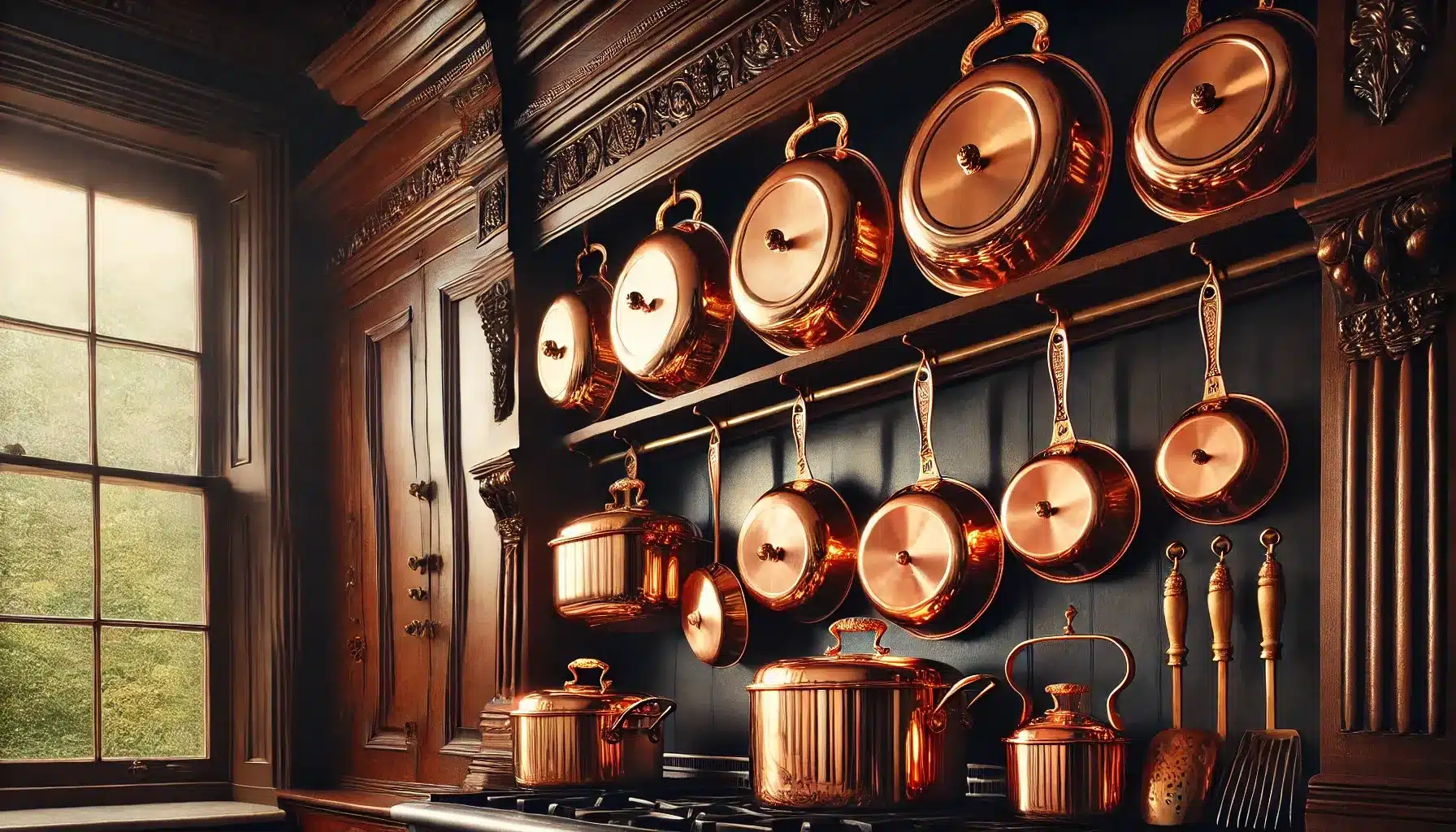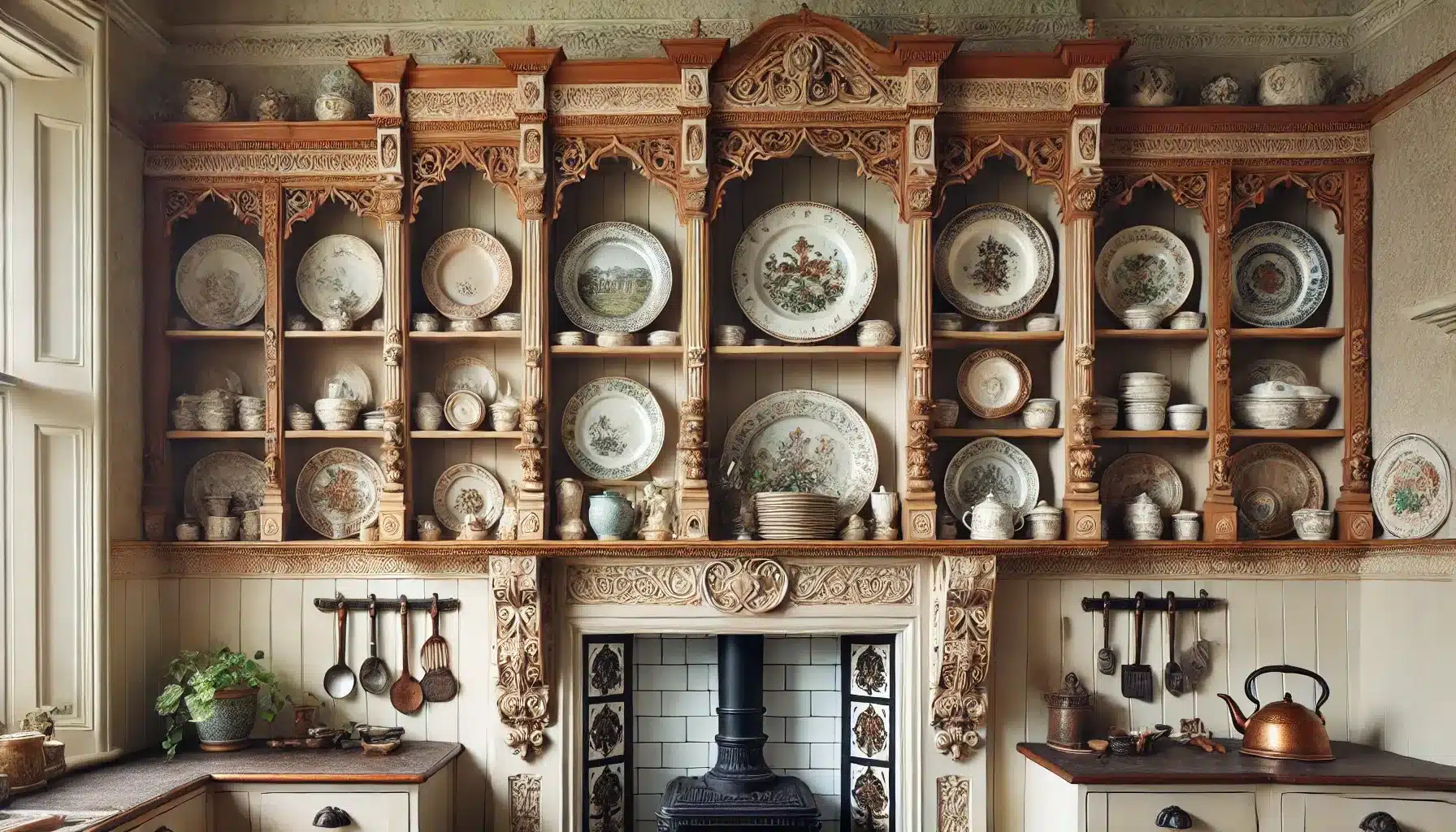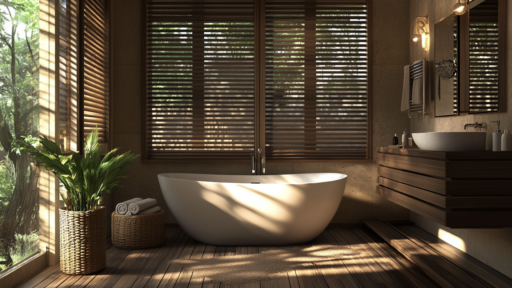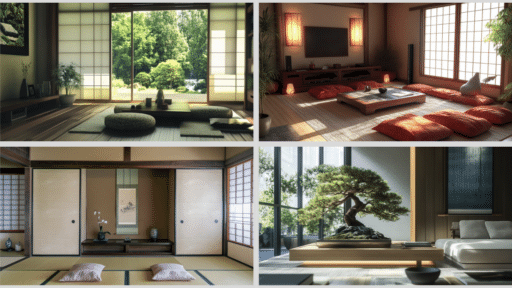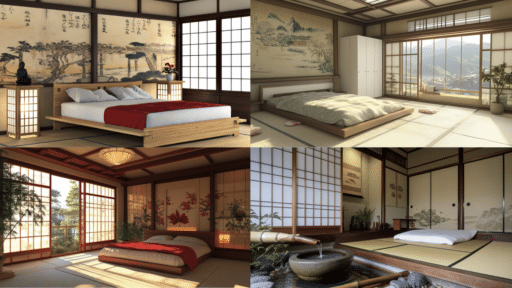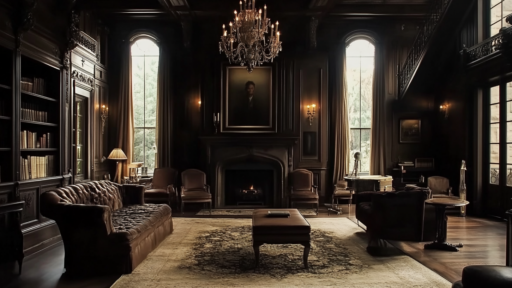Are you dreaming of a kitchen that blends classic charm with modern functionality? Victorian-style kitchens offer the perfect balance of elegance and practicality.
These designs bring warmth and character to your home’s heart, creating an inviting and functional space.
In this post, we’ll explore over 36 iconic Victorian kitchen designs that can transform your cooking area.
You’ll discover how to blend period features with contemporary touches, creating a kitchen that’s both timeless and on-trend.
We’ll look at color schemes, cabinetry styles, flooring options, and decorative elements that define Victorian kitchens.
Whether you’re planning a full renovation or just want to add a touch of Victorian flair, you’ll find plenty of ideas to make your kitchen stand out.
Popular Victorian Kitchen Designs
1. Dark Wooden Cabinets
Victorian kitchens prominently feature dark wooden cabinets, crafted from rich mahogany, walnut, or oak.
The deep, polished wood gives a sense of warmth and formality, creating a refined atmosphere. Intricate carvings on the doors and frames add a touch of artistry.
These cabinets were built to last, providing ample storage for kitchen essentials. The dark wood also helps hide wear and tear, maintaining the timeless elegance of the Victorian era.
- Pairs Best With: Dark cabinets work beautifully with light marble countertops to create contrast and sophistication.
2. Butler’s Pantry
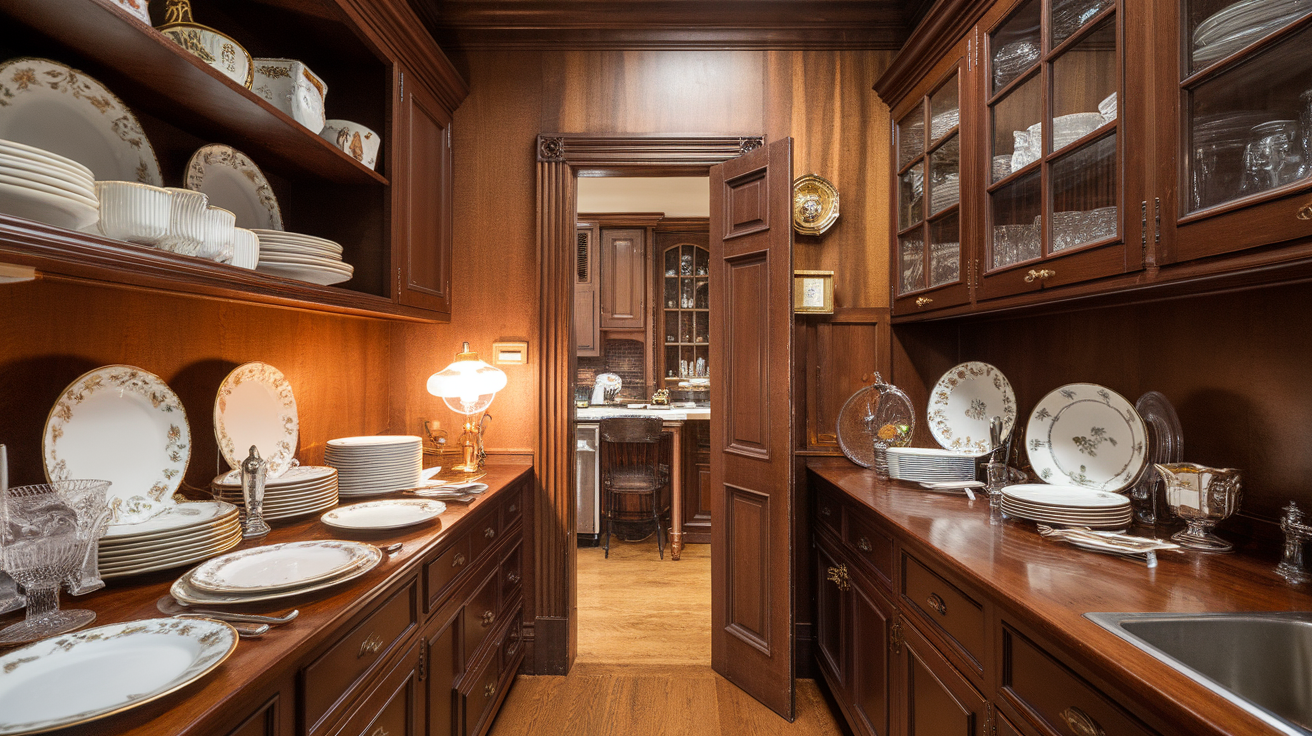
A butler’s pantry is a small room adjacent to the main kitchen, used for additional storage and meal preparation.
In Victorian homes, this pantry often housed fine china, silverware, and extra provisions. It was essential for larger households, where formal dining was common.
The butler’s pantry acted as a staging area for serving food, minimizing traffic in the main kitchen.
- Pairs Best With: Butler’s pantries often featured glass-front cabinets to display fine china and crystalware, keeping them safe yet easily accessible.
3. Cast Iron Range
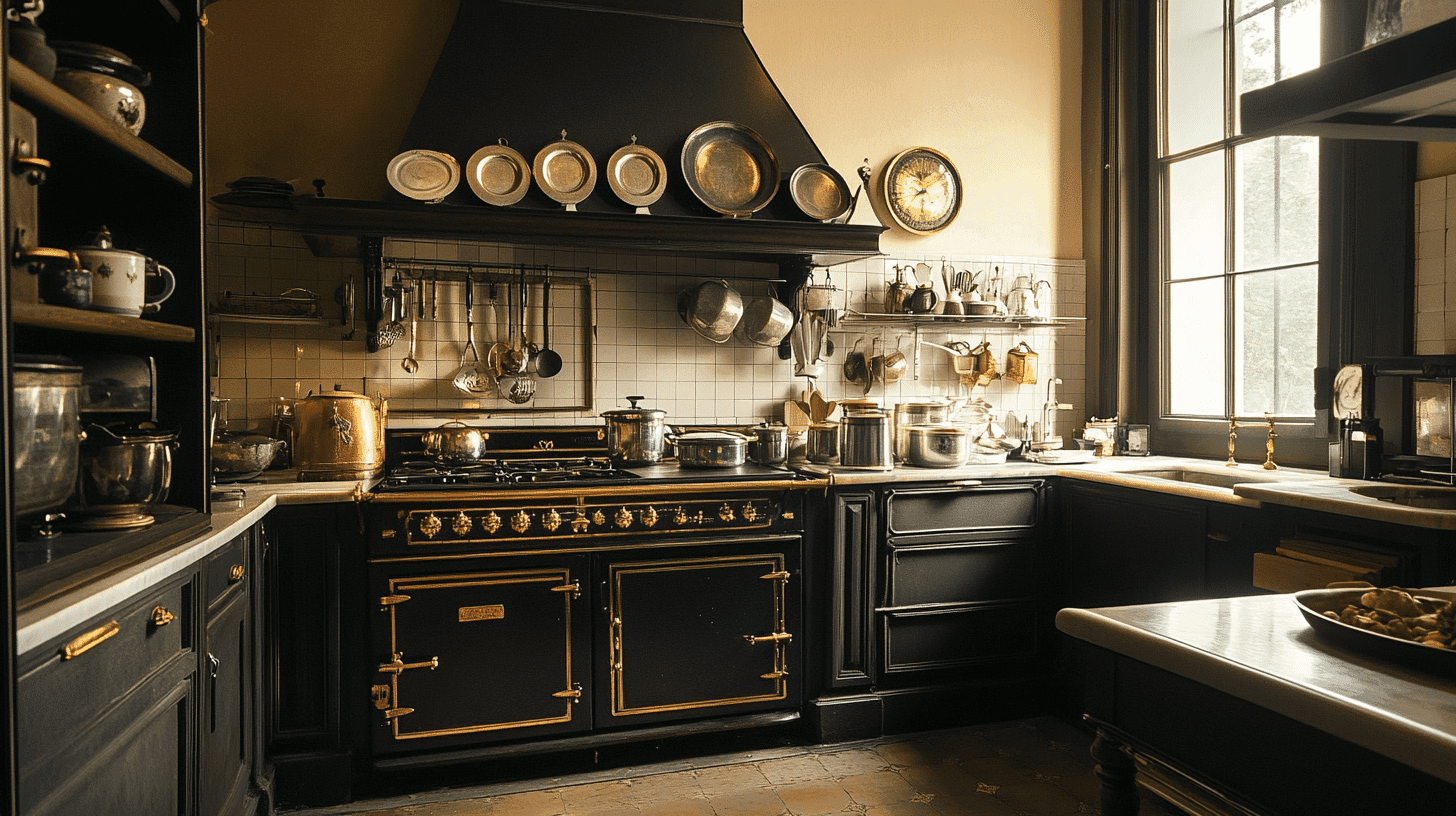
The cast iron range was a centerpiece in Victorian kitchens, combining durability and function.
These ranges were typically black, heavy, and intricately designed. They provided even heat for cooking, baking, and heating water.
Some models included multiple burners, ovens, and warming compartments. Cast iron ranges were labor-intensive to use but highly efficient for large households.
- Pairs Best With: A cast iron range pairs well with brass accessories like cooking utensils and range hoods, adding a touch of shine to the dark iron.
4. Farmhouse Sink
Farmhouse sinks, also known as apron-front sinks, are deep and wide, perfect for washing large pots and pans.
Made from durable materials such as ceramic or cast iron, these sinks stand out with their exposed front.
The spacious design was practical for Victorian homes, where meal preparation was extensive. Their sturdy construction ensures long-lasting utility, and their classic look is still highly sought after today.
- Pairs Best With: Pairing a farmhouse sink with brass or copper faucets elevates the sink’s rustic charm and enhances the kitchen’s overall vintage appeal.
5. Tile Backsplashes
Victorian kitchens often featured decorative tile backsplashes, showcasing intricate patterns and hand-painted designs.
These tiles were not just for aesthetics but also served a functional purpose by protecting walls from spills and splashes.
The designs ranged from floral motifs to geometric shapes, reflecting the decorative tendencies of the era. Color palettes were typically muted earth tones, but brighter hues were used in more opulent homes.
- Pairs Best With: A tile backsplash complements marble countertops, offering both elegance and protection while adding a personalized artistic touch.
6. Marble Countertops
Marble countertops in Victorian kitchens offered both practicality and luxury.
Their smooth surface was ideal for baking, rolling dough, and preparing food. Marble was chosen for its cooling properties and its elegant appearance, adding a high-end finish to the kitchen.
The subtle veining in marble provides a sense of uniqueness, making each countertop a one-of-a-kind piece.
- Pairs Best With: Marble countertops pair beautifully with dark wooden cabinetry, offering a striking contrast between the warm wood tones and cool marble.
7. Victorian Floor Tiles
Victorian floor tiles were a hallmark of opulence, often featuring intricate geometric or floral patterns.
Made from ceramic or encaustic tiles, they provided durability and easy maintenance. The designs added personality to the kitchen, often reflecting the homeowner’s taste.
These tiles were usually laid in contrasting colors like black and white or red and cream, creating eye-catching patterns.
- Pairs Best With: Floor tiles pair well with wainscoting, creating a cohesive Victorian aesthetic that runs from the floor to the walls.
8. Ceiling Beams
Exposed ceiling beams in Victorian kitchens provided a rustic charm, giving the space a more traditional, grounded feel.
Typically made from oak or pine, the beams were often stained or left in their natural state to highlight their grain.
These beams added architectural interest to the kitchen, contrasting with the refined, polished surfaces below.
- Pairs Best With: Ceiling beams are perfectly complemented by hanging lanterns, offering both a visual and functional pairing that emphasizes height and light.
9. Gas Lamps
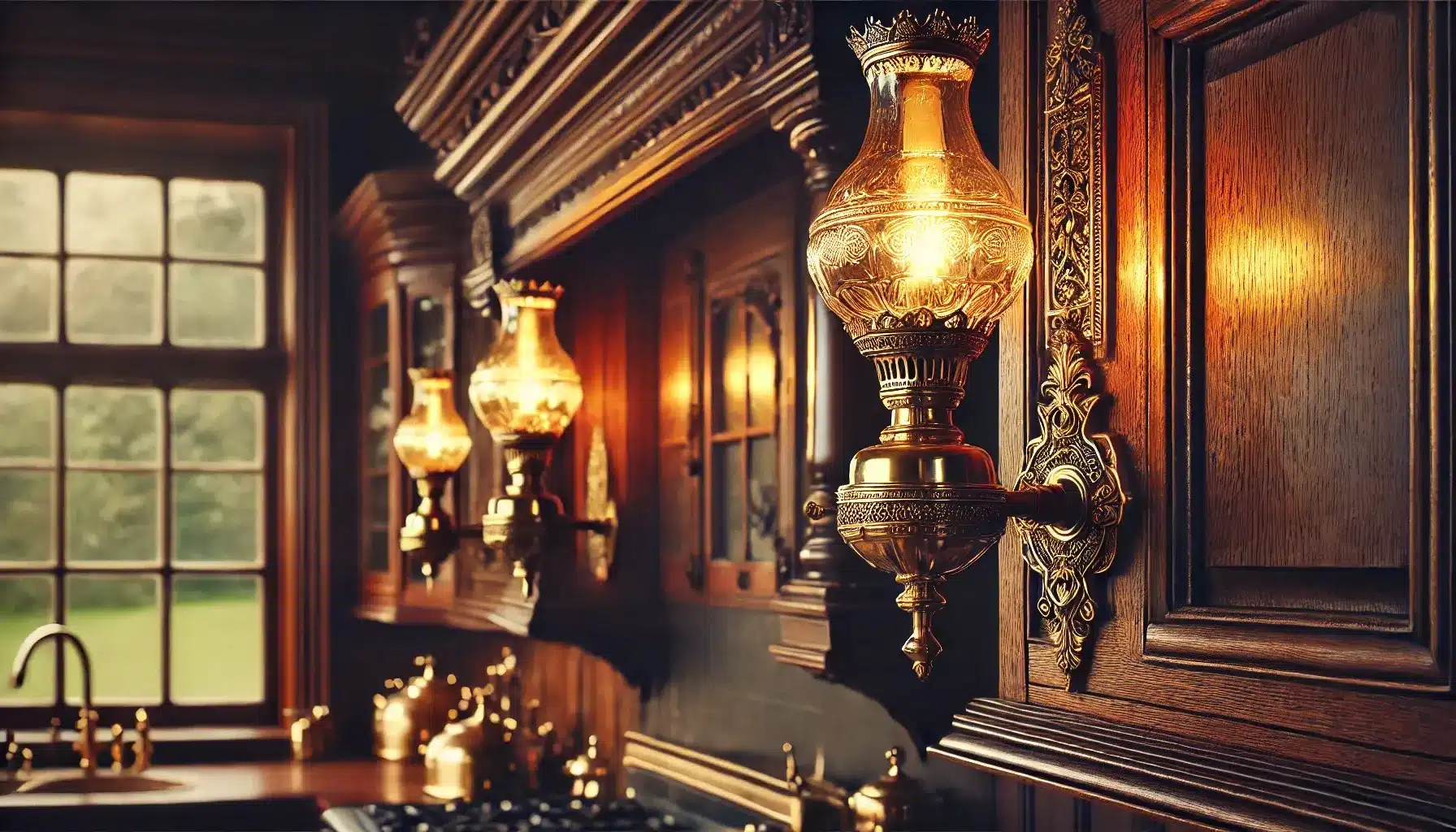
Gas lamps were a primary source of illumination in Victorian kitchens before electricity became widespread.
These lamps featured intricate metalwork, often made of brass or iron, adding a decorative element to their functionality.
They provided a warm, ambient light that created a cozy atmosphere. Their soft glow was especially effective for evening meal preparations.
- Pairs Best With: Gas lamps pair nicely with decorative cornices, adding both light and texture to the upper reaches of the kitchen.
10. Glass-Front Cabinets
Glass-front cabinets allowed Victorian homeowners to display their fine china and glassware while keeping them safely stored.
These cabinets often featured beveled or stained glass, adding artistic detail to their function.
The transparency offered a glimpse of the items inside, creating visual interest and a sense of openness in the kitchen.
- Pairs Best With: Glass-front cabinets pair beautifully with brass handles, offering a touch of shine that elevates the overall elegance of the space.
11. Victorian Wallpaper
Wallpaper was a popular choice in Victorian kitchens, adding color and pattern to the walls.
The designs often featured intricate floral motifs, damasks, or geometric patterns, reflecting the ornate tastes of the time.
Kitchens typically had washable or oilcloth wallpaper for practicality, but the designs were no less detailed.
Wallpaper was used to bring warmth and character into the room, often serving as a backdrop for decorative woodwork and other features.
- Pairs Best With: Victorian wallpaper pairs well with wainscoting, combining decorative upper walls with practical lower paneling for a balanced look.
12. Victorian Range Hoods
Victorian range hoods were often grand and ornate, made from materials such as copper or brass.
These hoods were not just functional but also served as a decorative focal point in the kitchen.
They helped ventilate the room, removing cooking odors and excess heat. The design often included intricate metalwork, matching other hardware in the kitchen.
- Pairs Best With: Range hoods pair excellently with cast iron ranges, creating a cohesive look that blends heavy, industrial elements with decorative accents.
13. Apothecary Jars
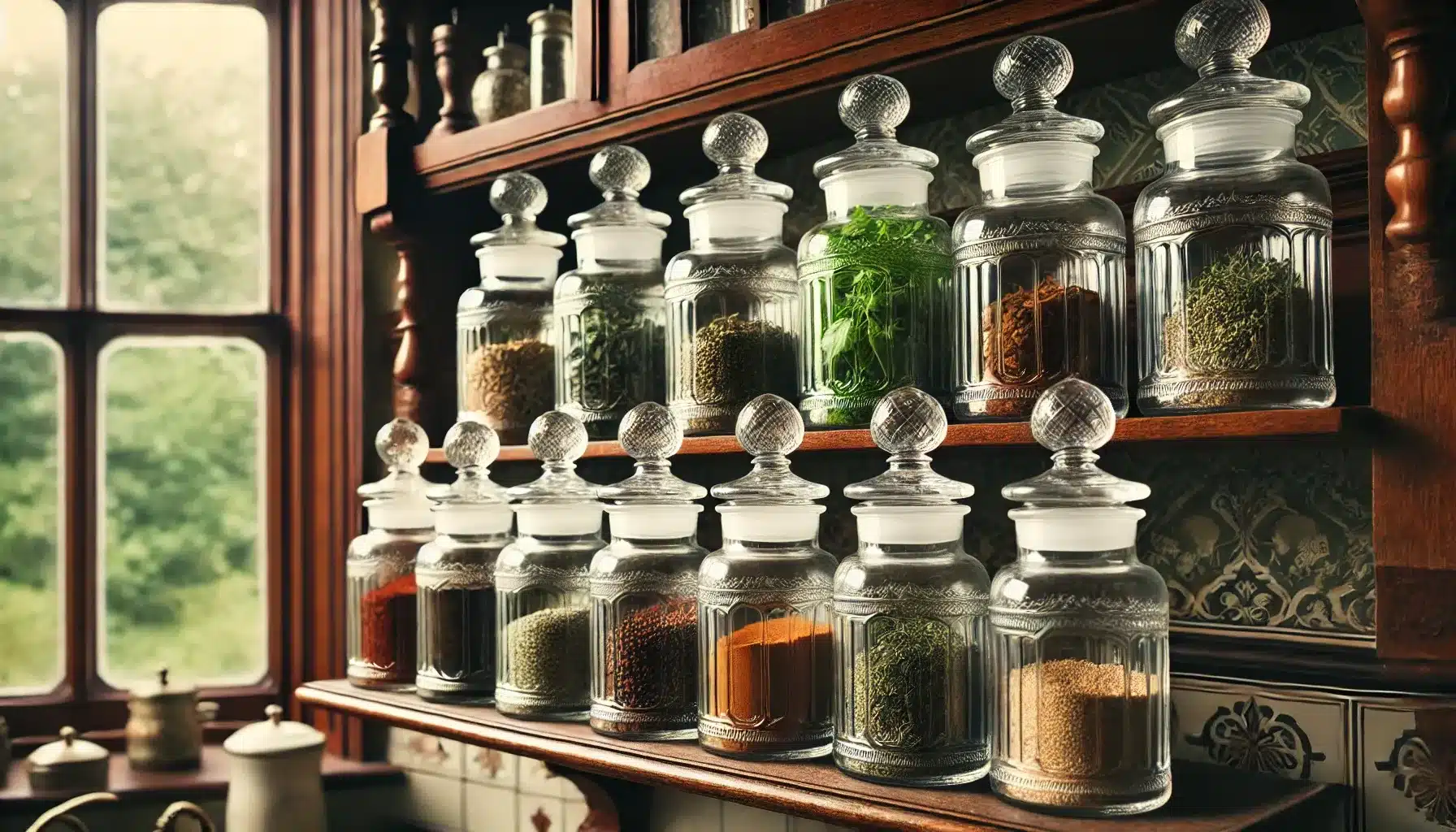
Apothecary jars were commonly used in Victorian kitchens for storing dry goods, herbs, and spices.
These glass jars, often with airtight lids, allowed for easy identification of contents while keeping them fresh.
Apothecary jars added both functionality and charm to the kitchen, often displayed on open shelves or in cupboards.
Their clear glass design was simple yet elegant, allowing them to blend seamlessly into any Victorian kitchen setting.
- Pairs Best With: Apothecary jars pair beautifully with open shelving, offering both easy access and an attractive display of stored goods.
14. Ornate Handles and Knobs
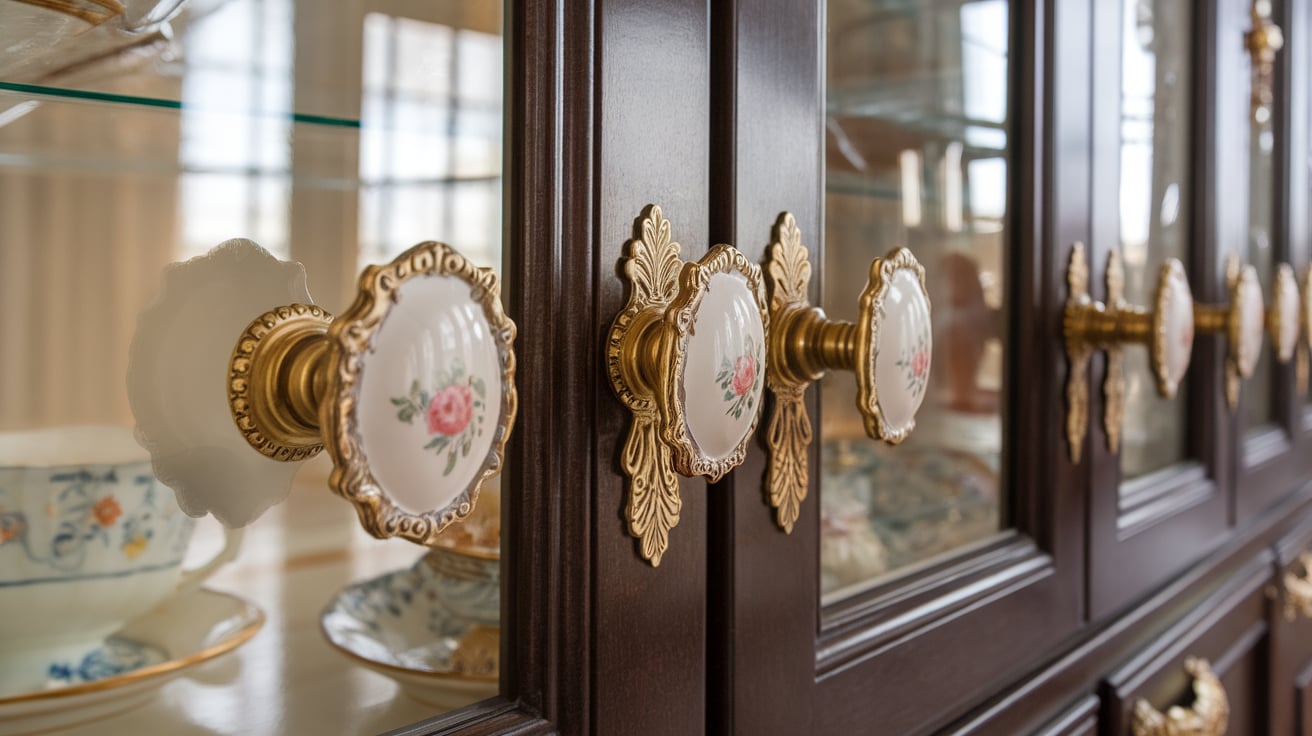
In Victorian kitchens, handles and knobs were often made of brass, porcelain, or glass, featuring minute designs.
These small details added elegance to cabinets and drawers, reflecting the era’s attention to craftsmanship.
Brass knobs were typically polished to a high shine, while porcelain ones often had hand-painted floral designs. These handles contributed to the overall decorative feel of the kitchen.
- Pairs Best With: Ornate handles, and knobs pair beautifully with glass-front cabinets, combining transparency and detailed metalwork for a refined look.
15. Open Shelving
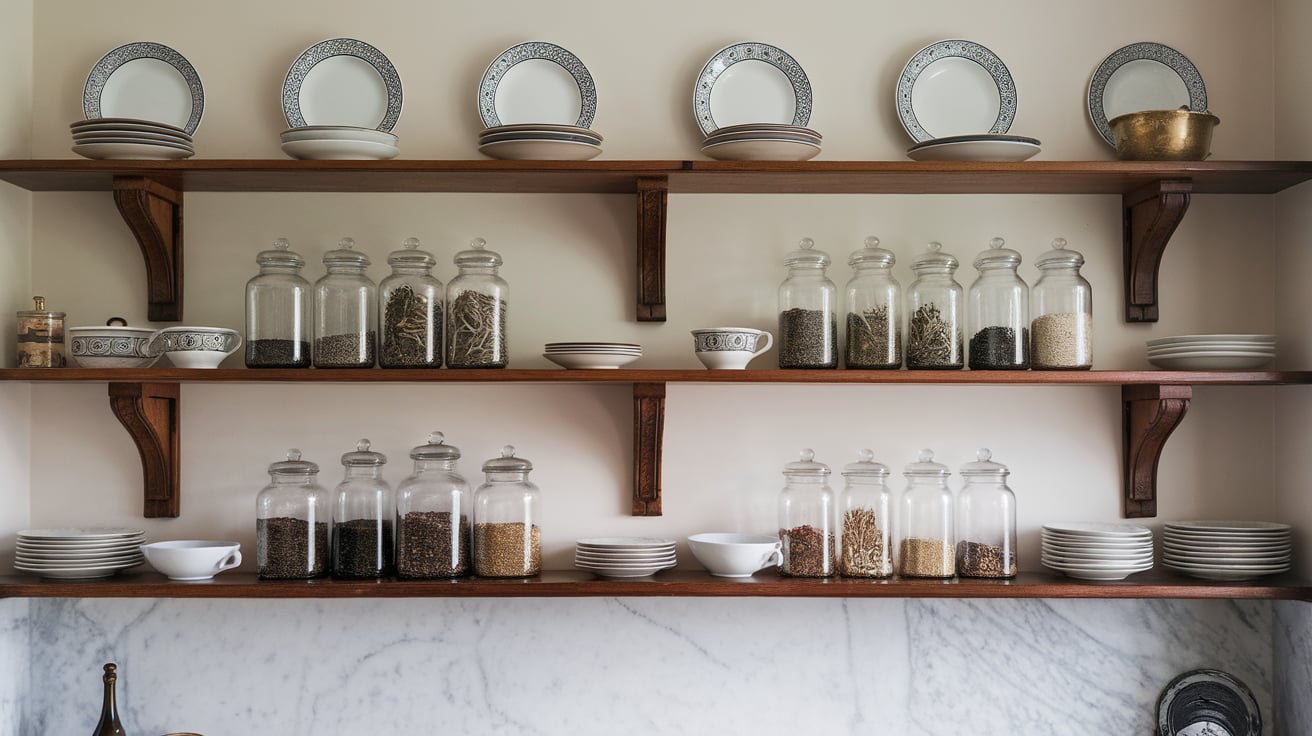
Open shelving was a practical and aesthetic choice in Victorian kitchens.
These shelves allowed easy access to frequently used items like plates, cups, and spices while also serving as a display for decorative kitchenware.
Made from wood or metal, they were often positioned above countertops or along walls. Open shelving provided an opportunity to showcase the homeowner’s taste in crockery and glassware.
- Pairs Best With: Open shelving pairs wonderfully with apothecary jars, offering a visually appealing and functional storage solution that keeps everything within easy reach.
16. Wainscoting
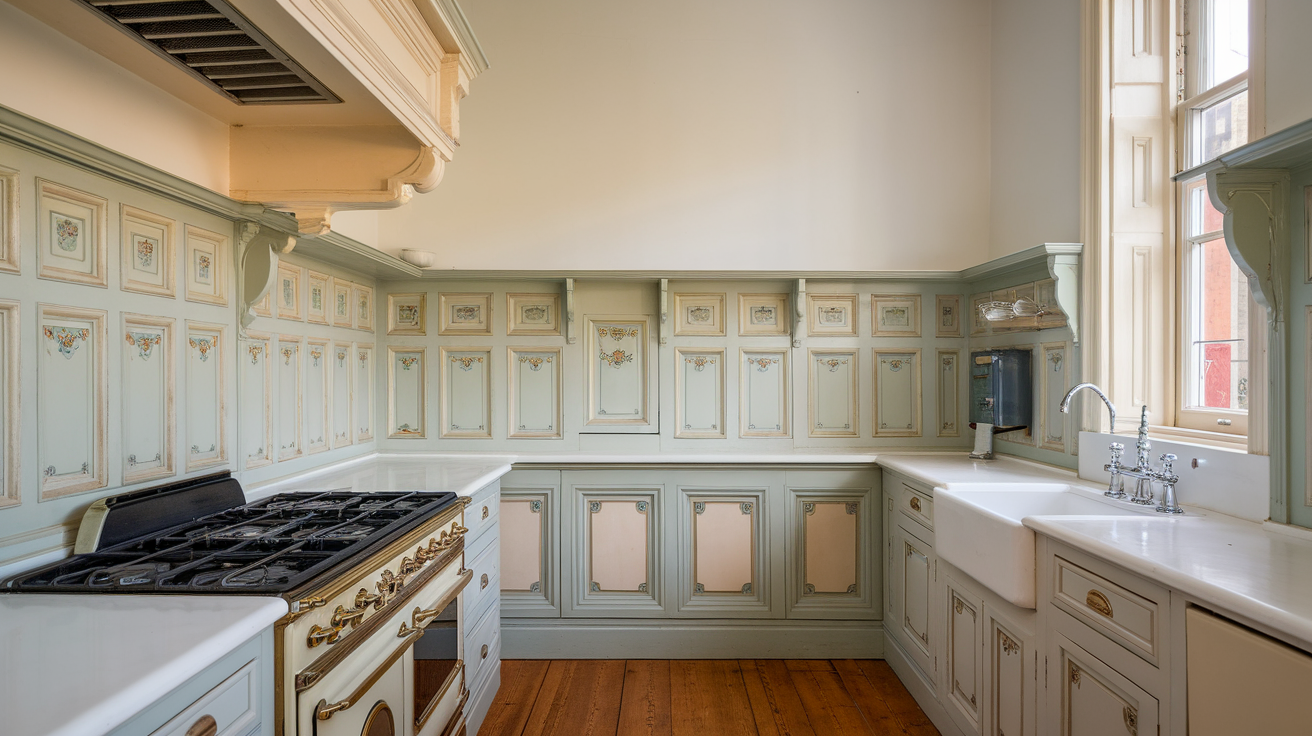
Wainscoting, often made from wood paneling, added texture and visual interest to Victorian kitchens.
Typically installed on the lower half of the walls, it provided protection from scuffs and stains. The wood was often painted in neutral or pastel shades to complement the rest of the kitchen.
The vertical lines of the paneling added height to the room, making the kitchen feel larger and more open.
- Pairs Best With: Wainscoting pairs well with Victorian floor tiles, creating a harmonious blend of textures from floor to wall.
17. Patterned Linoleum Floors
Linoleum floors became popular in Victorian kitchens due to their durability and ease of cleaning. The floors often featured intricate patterns, including geometric designs or floral motifs.
The wide range of colors and patterns allowed homeowners to personalize their kitchens, making the floors not just functional but a decorative statement.
Linoleum was also more affordable than natural stone, providing a practical yet stylish alternative.
- Pairs Best With: Patterned linoleum floors pair beautifully with freestanding furniture, creating a dynamic combination of form and function.
18. Lead Glass Windows
Victorian kitchens often featured lead glass windows, which added a decorative touch while allowing natural light to flood the space.
These windows were typically adorned with stained or patterned glass, creating a kaleidoscope of colors.
The intricate designs on the glass also provided privacy without sacrificing the elegance of the kitchen.
- Pairs Best With: Lead glass windows pair perfectly with dark wooden cabinetry, contrasting the colorful light with rich wood tones for a dramatic effect.
19. High Ceilings
High ceilings were a hallmark of Victorian homes, including the kitchen. These ceilings created a sense of grandeur and openness, making even smaller kitchens feel spacious.
The extra height also allowed for larger windows, increasing the amount of natural light.
High ceilings provided an opportunity for homeowners to incorporate decorative elements like chandeliers, cornices, or ceiling beams, adding to the overall elegance.
- Pairs Best With: High ceilings pair beautifully with chandeliers, creating a visually stunning combination of light and height that enhances the room’s luxury.
20. Built-In Dressers
Built-in dressers in Victorian kitchens were both practical and decorative. These large wooden pieces were designed to store fine china, glassware, and kitchen linens.
The dressers were often adorned with detailed carvings and glass-fronted doors, allowing for the display of elegant dishware.
The built-in nature made them a permanent and substantial kitchen feature, contributing to its overall aesthetic.
- Pairs Best With: Built-in dressers pair well with open shelving, offering a balance of enclosed storage and display space for functional and decorative items.
21. Oilcloth Tablecloths
Oilcloth tablecloths were a staple in Victorian kitchens due to their durability and ease of cleaning.
Made from cotton coated with oil or wax, these tablecloths were waterproof, making them ideal for busy kitchens.
They often featured bright, floral patterns or geometric designs, adding a cheerful and practical element to the kitchen.
Oilcloth tablecloths were widely used in households for protecting tables during meal preparation and dining.
- Pairs Best With: Oilcloth tablecloths pair beautifully with pine kitchen tables, combining rustic charm with practical protection.
22. Larder Cupboards
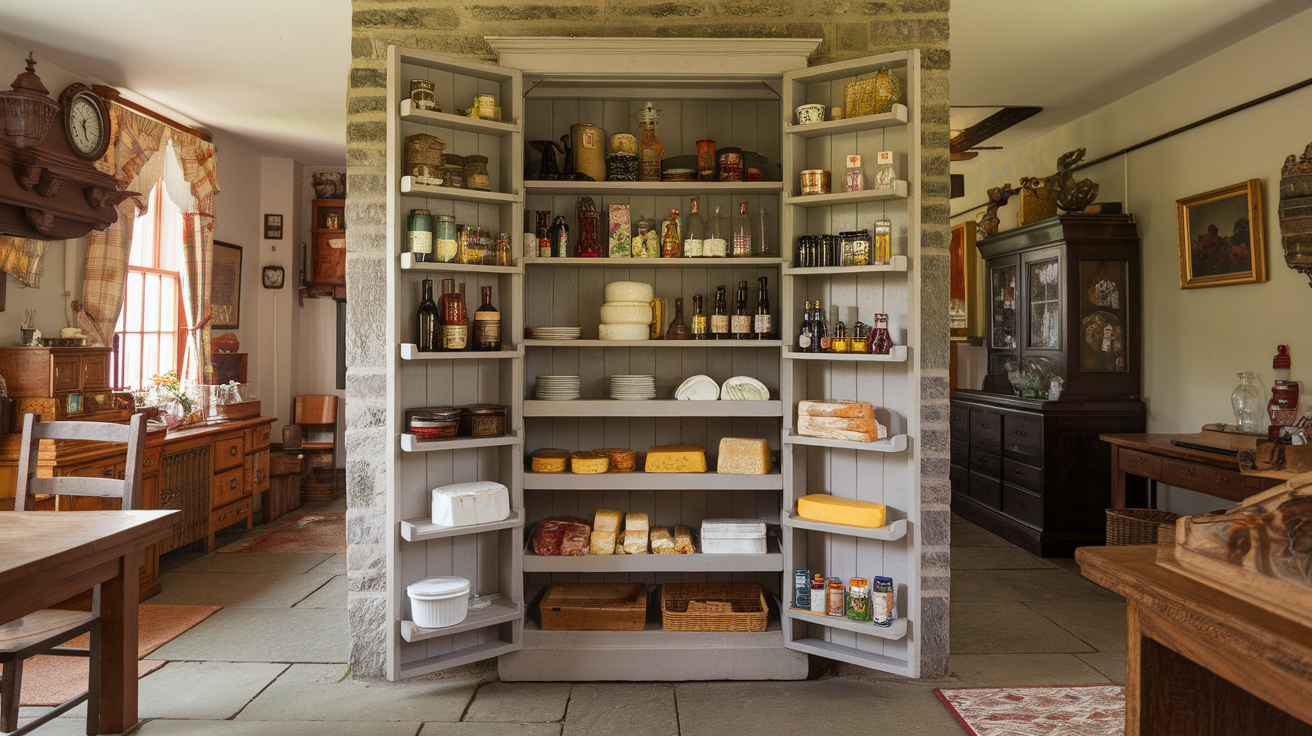
Larder cupboards were essential in Victorian kitchens. They served as a cool, dry place to store food, particularly perishable items like butter, cheese, and cured meats.
These tall, narrow cupboards were often lined with metal or stone to maintain a consistent temperature.
Larder cupboards helped keep the kitchen organized and efficient, ensuring food remained fresh for longer periods.
- Pairs Best With: Larder cupboards pair well with marble countertops, as both elements focus on functionality and maintaining cool temperatures in the kitchen.
23. Victorian Fireplaces
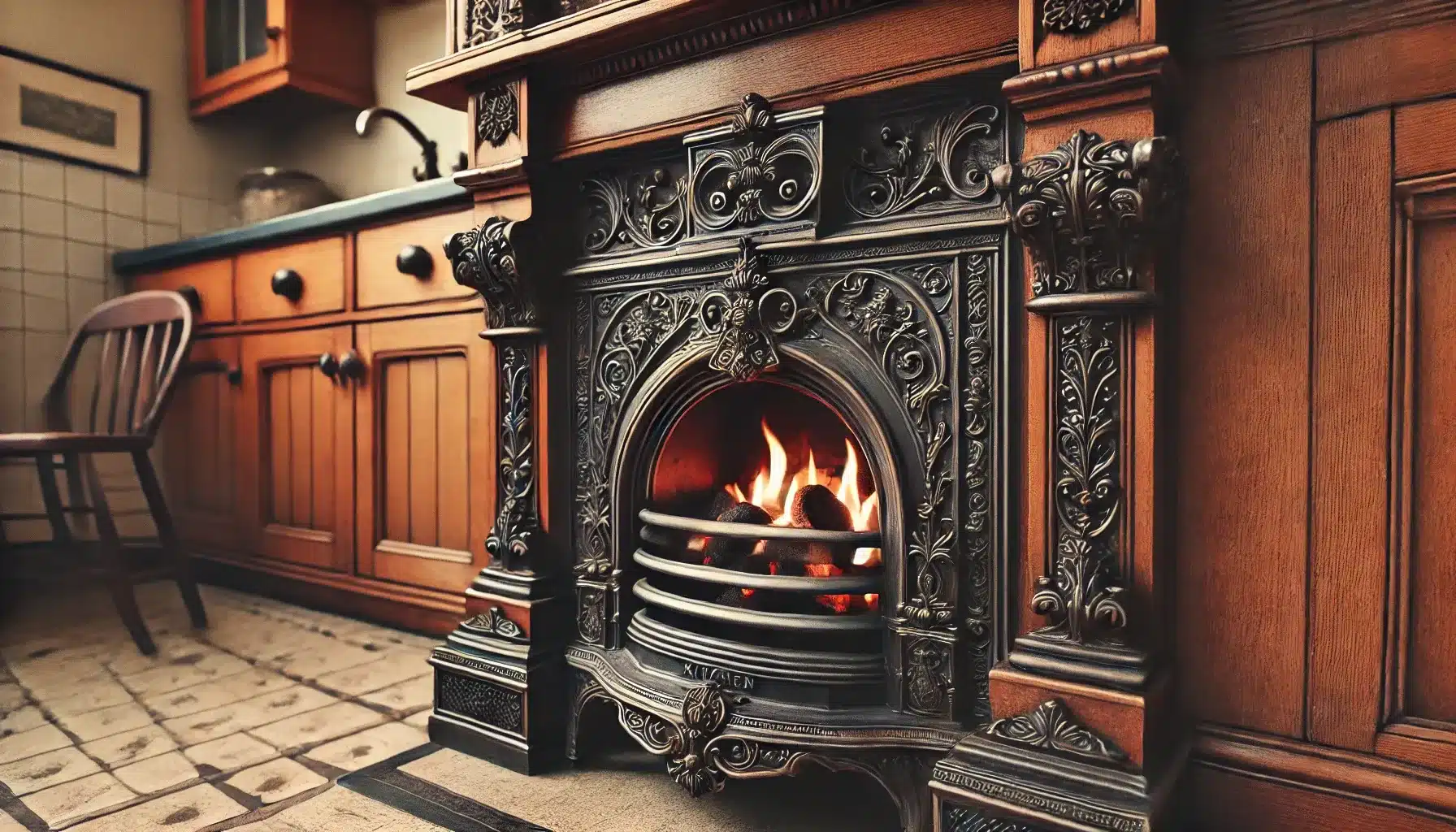
Victorian fireplaces were a central feature in larger kitchens, providing both heat and a place to cook.
These fireplaces often featured intricate cast iron grates and mantels, reflecting the ornate design of the era.
Some were purely decorative, while others were used for roasting meats or baking bread.
The warmth from the fireplace also helped dry out the kitchen, especially during colder months, making it a vital element of the Victorian home.
- Pairs Best With: Victorian fireplaces pair beautifully with Minton tiles, using decorative tilework to frame the hearth and enhance the kitchen’s overall elegance.
24. Minton Tiles
Minton tiles were often used in Victorian kitchens for their beauty and durability.
These encaustic tiles, made by the Minton company, featured intricate, multicolored patterns and were used for both flooring and wall decoration.
The tiles were hard-wearing, making them ideal for high-traffic areas like kitchens. Their detailed designs added an artistic element, turning practical surfaces into focal points.
- Pairs Best With: Minton tiles pair perfectly with Victorian fireplaces, where they are often used to frame the hearth and bring warmth to the room’s décor.
25. Chandelier Lighting
In Victorian kitchens, chandeliers were a symbol of luxury, often made from crystal or brass. These hanging fixtures provided more than just light; they added opulence to the space.
Though chandeliers were more common in dining rooms, they occasionally graced larger kitchens, especially in wealthier homes.
The intricate designs and shimmering light from the crystals created a focal point in the kitchen, elevating the space from functional to elegant.
- Pairs Best With: Chandelier lighting pairs beautifully with high ceilings, maximizing the impact of both features and creating a grand, open feel.
26. Exposed Brick Walls
Exposed brick walls gave Victorian kitchens a rustic, industrial edge. Originally used for practical reasons, brick became a design statement as it provided texture and warmth.
The natural tones of the brick contrasted with more polished surfaces, like marble countertops or dark wooden cabinets.
Exposed brick was a versatile design choice, blending both elegance and simplicity while offering durability.
- Pairs Best With: Exposed brick walls pair perfectly with wrought iron pot racks, combining industrial charm with functional kitchen storage.
27. Brass Faucets
Brass faucets were a popular choice in Victorian kitchens, known for their durability and shine.
These faucets were often elaborately designed, with curved spouts and decorative handles. Brass was resistant to corrosion, making it an ideal material for kitchen use.
The warm, golden hue of brass faucets added a touch of luxury to the kitchen, contrasting beautifully with white sinks or marble countertops.
- Pairs Best With: Brass faucets pair perfectly with farmhouse sinks, enhancing the rustic, yet refined look with their metallic sheen.
28. Victorian Plate Racks
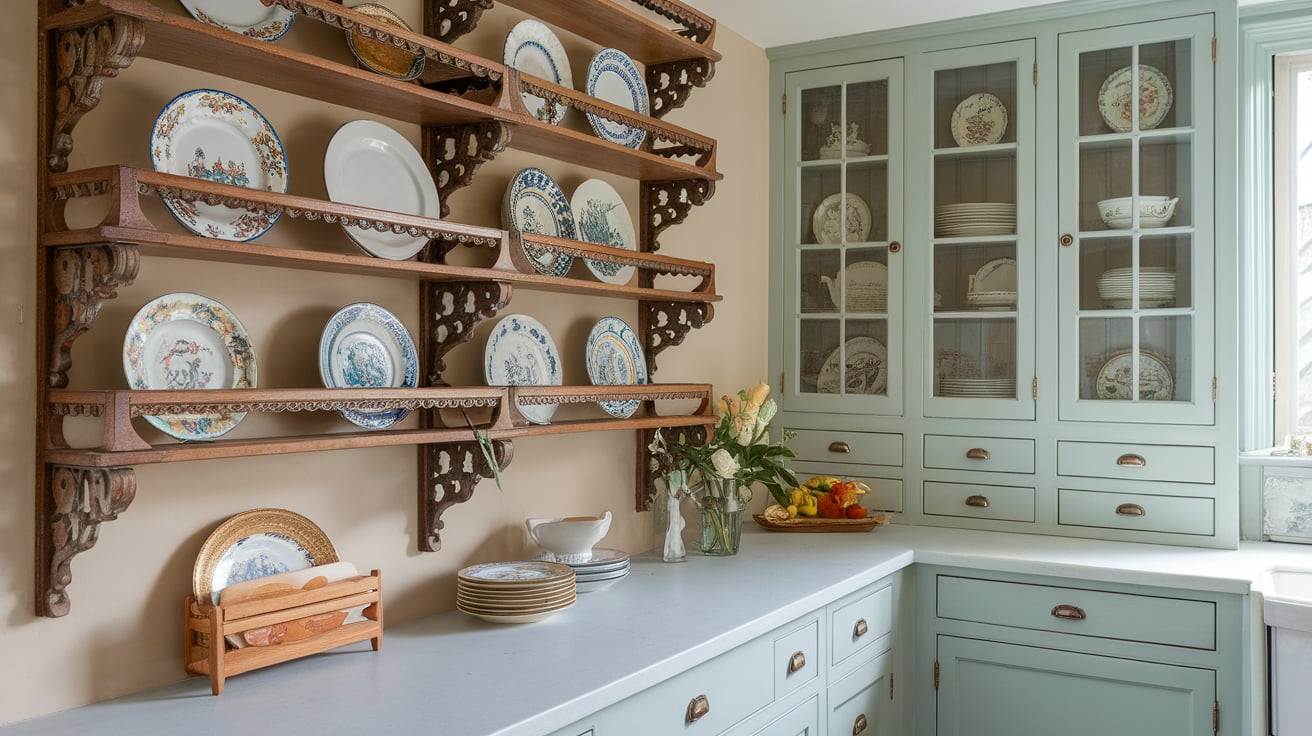
Victorian plate racks were functional yet decorative, often mounted on walls to store and display plates.
These racks featured detailed wood or metal designs, adding a charming, old-world touch to the kitchen.
The open design allowed plates to dry naturally while also showing off the homeowner’s fine china. Plate racks were particularly useful in smaller kitchens where storage space was limited.
- Pairs Best With: Plate racks pair beautifully with glass-front cabinets, offering a seamless blend of open and closed storage for displaying kitchenware.
29. Checkerboard Floors
Checkerboard floors, typically made from black and white tiles, were a classic design choice in Victorian kitchens.
The bold contrast of the tiles created a visually striking pattern, adding elegance and style. This flooring choice was also practical, as the alternating colors helped conceal dirt and wear.
Checkerboard floors reflected the Victorian love for symmetry and order, bringing a sense of balance to the space.
- Pairs Best With: Checkerboard floors pair well with dark wooden cabinetry, offering a striking contrast between the dark wood and the bright tile pattern.
30. Pine Kitchen Tables
Pine kitchen tables were a staple in Victorian kitchens, known for their durability and rustic charm.
These solid wood tables were often the kitchen’s heart, used for food preparation and family meals.
The simplicity of the pine allowed for versatility in design, fitting into kitchens of all sizes. The wood’s natural grain added texture and warmth to the room, creating a cozy and inviting atmosphere.
- Pairs Best With: Pine kitchen tables pair beautifully with oilcloth tablecloths, combining practical protection with rustic charm.
31. Decorative Cornices
Victorian kitchens often featured decorative cornices along the ceiling, adding a touch of architectural detail.
These molded or carved designs ran along the tops of walls, where they met the ceiling, offering a polished, formal finish.
Cornices were often painted in soft, neutral colors to complement the room’s color palette.
- Pairs Best With: Decorative cornices pair beautifully with high ceilings, emphasizing the room’s height and adding visual depth.
32. Carved Wood Details
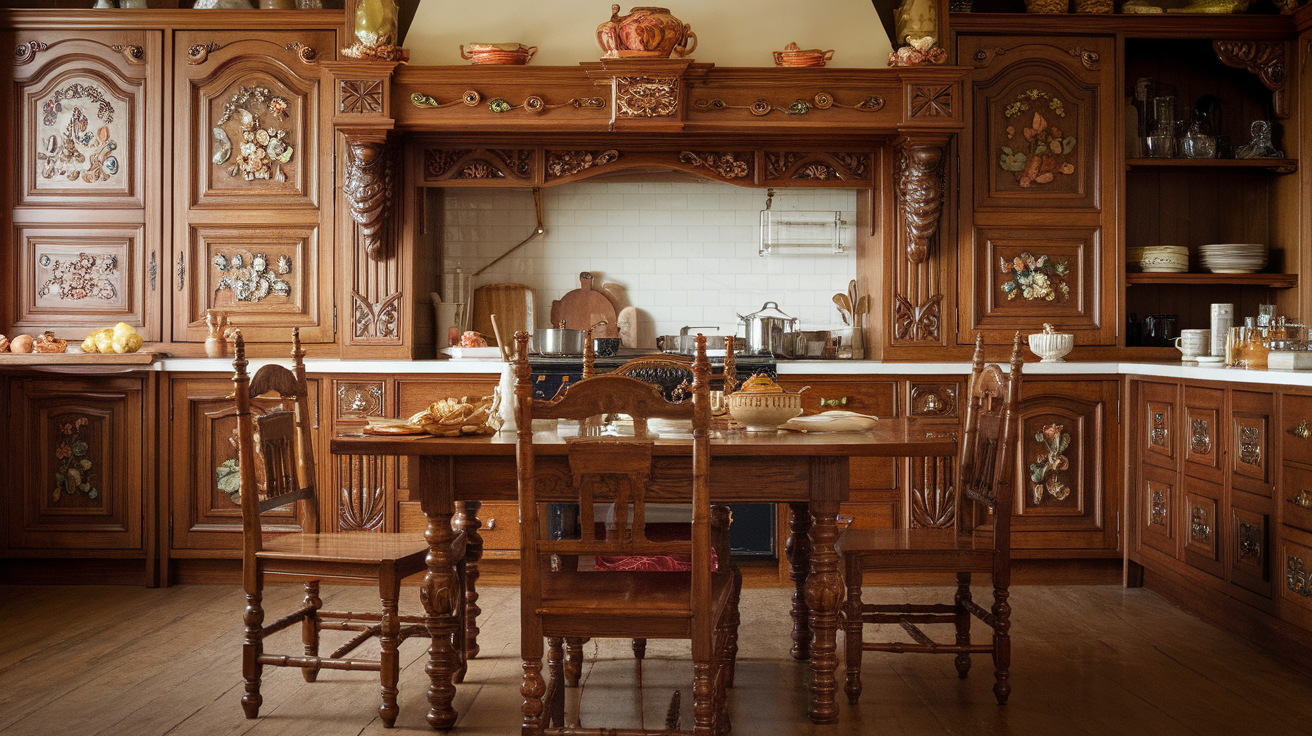
Intricate carved wood details were a hallmark of Victorian kitchen design. Cabinet doors, furniture legs, and mantels often featured hand-carved motifs, such as floral patterns, vines, or geometric designs.
These carvings reflected the craftsmanship of the era, turning functional elements into decorative pieces.
The detailed woodwork added richness to the kitchen, making it a reflection of the Victorian appreciation for artistry and beauty.
- Pairs Best With: Carved wood details pair wonderfully with marble countertops, balancing ornate designs with sleek, polished surfaces.
33. Copper Cookware
Copper cookware was both functional and decorative in Victorian kitchens.
These pots and pans, known for their excellent heat conduction, often hung from pot racks or were displayed on open shelves.
The warm, reddish hue of the copper added a rich, metallic sheen to the kitchen, contrasting beautifully with darker elements like wood or stone.
Copper cookware was a sign of luxury and refined taste, often polished to a high shine to enhance its visual appeal.
- Pairs Best With: Copper cookware pairs perfectly with hanging pot racks, turning practical storage into a statement of style and craftsmanship.
34. Overmantel Shelves
Overmantel shelves were a unique feature in some Victorian kitchens, providing extra storage space above the fireplace or range.
These shelves were often carved from wood and used to display decorative items such as plates, vases, or cookware.
The shelves added height to the room, drawing attention to the mantel and making the kitchen feel more cohesive. Overmantel shelves were both functional and decorative, serving as a focal point in the kitchen.
- Pairs Best With: Overmantel shelves pair beautifully with decorative cornices, enhancing the verticality and ornamentation of the room.
35. Clawfoot Table Legs
Clawfoot table legs were a distinctive feature of Victorian kitchen furniture, particularly on dining tables or work tables.
These intricately carved legs, resembling animal claws grasping a ball, were a symbol of luxury and craftsmanship.
The attention to detail in the carving added elegance to otherwise utilitarian furniture. Clawfoot legs were typically found on heavy, solid wood tables, grounding the room with their substantial presence.
- Pairs Best With: Clawfoot table legs pair excellently with patterned linoleum floors, offering a dynamic contrast between ornate furniture and geometric flooring.
36. Victorian Lanterns
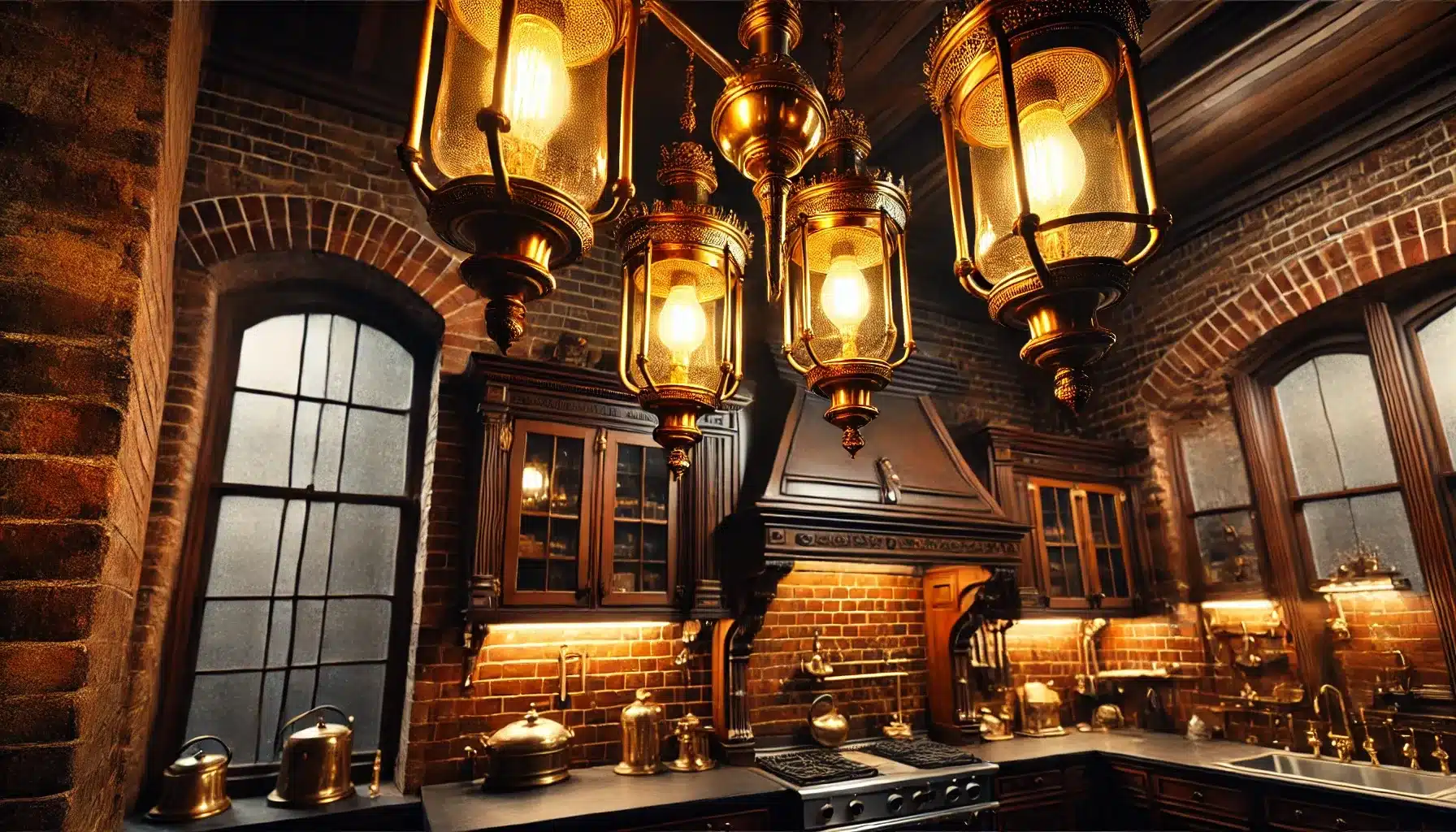
Victorian lanterns, often made of brass or wrought iron, were used to provide light in kitchens before electricity was common.
These lanterns had glass panels, sometimes frosted or etched, and were hung from the ceiling or mounted on walls.
The warm glow from the lanterns created a cozy, inviting atmosphere in the kitchen, while their intricate designs added a decorative element.
They were both practical and aesthetic, often complementing other metal elements in the kitchen.
- Pairs Best With: Victorian lanterns pair beautifully with exposed brick walls, enhancing the rustic, old-world charm of the space.
Conclusion
As you plan your kitchen makeover, consider which elements match the most with your personal style and the architecture of your home.
Remember, the key to a successful Victorian-style kitchen lies in balancing ornate details with practical features.
Don’t be afraid to mix and match ideas to craft a unique space that reflects your taste.
Whether you opt for a full Victorian revival or just want to incorporate a few period touches, your kitchen can become a stunning focal point of your home.
With careful planning and attention to detail, you’ll soon be enjoying a kitchen that’s not only beautiful but also a joy to cook and entertain in.
Ready to start your Victorian kitchen journey?



